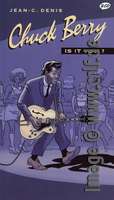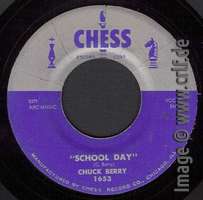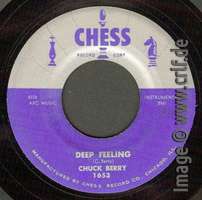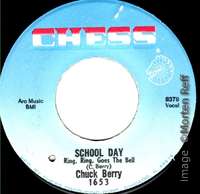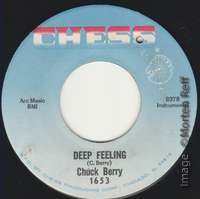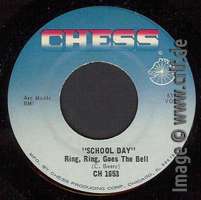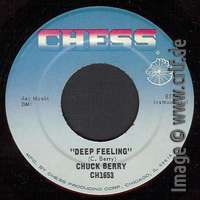Wednesday, April 10. 2024
The Chuck Berry Sound according to Atomicat
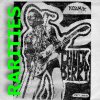
This site is about the music of Chuck Berry, i.e. his songs, his lyrics, his guitar playing, his singing, his arrangements. To define this Chuck Berry Sound is difficult because he used a multitude of styles from blues to ballads to pop and of course rockânâroll. But you also find instrumentals, poetry, nonsense lyrics, multi-tracked harmonies, and experimental rock in Berryâs oeuvre.
Thus when Atomicat Records recently released a CD titled âThe Chuck Berry Soundâ, it was interesting to learn how they would define the sound that comes from Berryâs music. Well, they couldnât concentrate either.
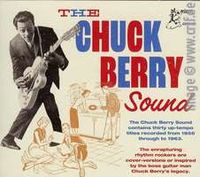
At first they took the easy route: cover versions. Eight of the tracks are written by Berry himself and thus obviously close to his sound. However, Atomicat selected cover version you probably have never heard of before, even though all songs on this CD are from the 1950s and early 1960s.
Hear you can listen to one of the earliest female singers working with Berry material: Margaret Lewis singing Roll Over Beethoven. Another very early cover version from 1956, and a funny one, is Too Much Monkey Business by The Gadabouts supported by Carl Stevenâs Orchestra. Several of the cover versions are very different from Berryâs own, especially Betty Jean by Terry Gale, Brown Eyed Handsome Man by Scotty McKay, Carol by Jim Miller, and Rock'n'Roll Music by Jimmy Breedlove. Further cover versions included are Johnny B. Goode by Gootch Jackson with Herbie Layne's Orchestra and Thirty Days by Wes Reynolds, though titled Forty Days like the Ronnie Hawkins version.
A second set of tracks on this CD contains recordings which sound like Chuck Berry hits. Both Brownie McGheeâs Anna Mae, Rayvon Darnellâs Don't Want You Maybellene, and Buddy Lucasâ Oh Mary Ann were recorded in late 1955 and sound very much like Berryâs then hit Maybellene. Further soundalikes are Rhythm Feet by Carroll (Wild Red) Pegues which is similar to Around And Around, School Day Blues by Johnny And The Jammers (close to Brown Eyed Handsome Man), Pony Tail Girl by Glenn Garrison (Sweet Little Sixteen), and Knockin' On Your Door by Jimmy King (School Day). Two songs use the melody and pattern of Reelinâ And Rockinâ: Tiny Morrieâs Everybody Rocks and the non-twisting Mother Goose Twist by Oliver And The Twisters which by the way at 2:44 minutes is the longest of all the short songs on this album.
Most people will list Berryâs guitar playing as one or as the main element of âThe Chuck Berry Soundâ, ignoring that Berry reused guitar playing well-known before in Blues and Jazz. Anyway Atomicat identified guitar-oriented songs from the late 1950s and early 1960s on which the guitar players do not hide that they found these riffs on Berry records. Even though Atomicat tried to find the names of these guitarists, they did not succeed with every song. Some of the probably session musicians will remain anonymous.
Berry-inspired guitar solos can be found in Dee Clarkâs Dance On Little Girl (guitar: Phil Upchurch) and The New Blockbustersâ Rock & Roll Guitar Part 1 (guitar: Paul Buskirk). On Ray Sharpeâs Justine, Tony Casanovaâs (i.e. Jutillo Perezâ) Showdown and Billy Peekâs Rock To The Top the main artists both sing and play the Berry guitar. Unknown guitarist provide Berry-like guitar playing on Buddy Howardâs Take Your Hands Off Me Baby, Jerry Hawkinsâ Swing Daddy Swing, and The Jet Tonesâ Henry.
If you want to count Caveman by Tommy Roe and The Satins as a Berry soundalike is doubtful, though, at least to me. And to accept Eddie Clearwaterâs I Was Gone here requires you to know that Edward Harrington (his real name) was not only a Berry soundalike (with many other recordings and cover versions) but also a Berry lookalike in his 1960s shows.
The remaining three songs from this 30-track CD are tribute songs to Chuck Berry himself or to his best-known protagonist. The Dusters sing about a show with both Chuck Berry and Jerry Lee Lewis (Rock At The Hop, 1961). Leonard Douglas Drake under his alias Big Daddy G in 1963 recorded a tribute song called Big Berry (Boss Man Guitar) in which he combines Berry song titles. Finally Eddy Bell and the Bel-Aires from 1961 continue the Johnny B. Goode saga with Johnny Be-Goode Is In Hollywood.
All in all âThe Chuck Berry Soundâ (Atomicat Records ACCD162) is an interesting selection of recordings which show Berryâs influence on other musicians. All these were released long before the Beat craze when all the successful bands listed Berry as one of their main influencers. The latest recording on this set is from 1963. while the earliest start close after Berryâs first chart hit. This is not a CD you will play over and over, but itâs a rare chance to listen to fairly old and hard to find Berry-inspired music.
Thus when Atomicat Records recently released a CD titled âThe Chuck Berry Soundâ, it was interesting to learn how they would define the sound that comes from Berryâs music. Well, they couldnât concentrate either.

At first they took the easy route: cover versions. Eight of the tracks are written by Berry himself and thus obviously close to his sound. However, Atomicat selected cover version you probably have never heard of before, even though all songs on this CD are from the 1950s and early 1960s.
Hear you can listen to one of the earliest female singers working with Berry material: Margaret Lewis singing Roll Over Beethoven. Another very early cover version from 1956, and a funny one, is Too Much Monkey Business by The Gadabouts supported by Carl Stevenâs Orchestra. Several of the cover versions are very different from Berryâs own, especially Betty Jean by Terry Gale, Brown Eyed Handsome Man by Scotty McKay, Carol by Jim Miller, and Rock'n'Roll Music by Jimmy Breedlove. Further cover versions included are Johnny B. Goode by Gootch Jackson with Herbie Layne's Orchestra and Thirty Days by Wes Reynolds, though titled Forty Days like the Ronnie Hawkins version.
A second set of tracks on this CD contains recordings which sound like Chuck Berry hits. Both Brownie McGheeâs Anna Mae, Rayvon Darnellâs Don't Want You Maybellene, and Buddy Lucasâ Oh Mary Ann were recorded in late 1955 and sound very much like Berryâs then hit Maybellene. Further soundalikes are Rhythm Feet by Carroll (Wild Red) Pegues which is similar to Around And Around, School Day Blues by Johnny And The Jammers (close to Brown Eyed Handsome Man), Pony Tail Girl by Glenn Garrison (Sweet Little Sixteen), and Knockin' On Your Door by Jimmy King (School Day). Two songs use the melody and pattern of Reelinâ And Rockinâ: Tiny Morrieâs Everybody Rocks and the non-twisting Mother Goose Twist by Oliver And The Twisters which by the way at 2:44 minutes is the longest of all the short songs on this album.
Most people will list Berryâs guitar playing as one or as the main element of âThe Chuck Berry Soundâ, ignoring that Berry reused guitar playing well-known before in Blues and Jazz. Anyway Atomicat identified guitar-oriented songs from the late 1950s and early 1960s on which the guitar players do not hide that they found these riffs on Berry records. Even though Atomicat tried to find the names of these guitarists, they did not succeed with every song. Some of the probably session musicians will remain anonymous.
Berry-inspired guitar solos can be found in Dee Clarkâs Dance On Little Girl (guitar: Phil Upchurch) and The New Blockbustersâ Rock & Roll Guitar Part 1 (guitar: Paul Buskirk). On Ray Sharpeâs Justine, Tony Casanovaâs (i.e. Jutillo Perezâ) Showdown and Billy Peekâs Rock To The Top the main artists both sing and play the Berry guitar. Unknown guitarist provide Berry-like guitar playing on Buddy Howardâs Take Your Hands Off Me Baby, Jerry Hawkinsâ Swing Daddy Swing, and The Jet Tonesâ Henry.
If you want to count Caveman by Tommy Roe and The Satins as a Berry soundalike is doubtful, though, at least to me. And to accept Eddie Clearwaterâs I Was Gone here requires you to know that Edward Harrington (his real name) was not only a Berry soundalike (with many other recordings and cover versions) but also a Berry lookalike in his 1960s shows.
The remaining three songs from this 30-track CD are tribute songs to Chuck Berry himself or to his best-known protagonist. The Dusters sing about a show with both Chuck Berry and Jerry Lee Lewis (Rock At The Hop, 1961). Leonard Douglas Drake under his alias Big Daddy G in 1963 recorded a tribute song called Big Berry (Boss Man Guitar) in which he combines Berry song titles. Finally Eddy Bell and the Bel-Aires from 1961 continue the Johnny B. Goode saga with Johnny Be-Goode Is In Hollywood.
All in all âThe Chuck Berry Soundâ (Atomicat Records ACCD162) is an interesting selection of recordings which show Berryâs influence on other musicians. All these were released long before the Beat craze when all the successful bands listed Berry as one of their main influencers. The latest recording on this set is from 1963. while the earliest start close after Berryâs first chart hit. This is not a CD you will play over and over, but itâs a rare chance to listen to fairly old and hard to find Berry-inspired music.
Tuesday, January 16. 2024
The Chuck Berry Vinyl Bootlegs, Vol. 3: America's Hottest Wax

This series of articles is going to describe the Chuck Berry vinyl bootlegs released in the 1970's and 1980's. For any record collector these items are important to know of, even though you don't necessarily need to have them. Omitted from all the usual discographies, information about these records is next to void. Given the secret nature of the bootlegger business there are no exact dates, numbers, or origins. I have tried to collect this information from various sources and mostly from my own collection of records. If you can add anything of worth to the information given here, I'd be glad to know!
This is the third part of this series and it covers another typical kind of bootleg record: a record containing studio outtakes.
Chuck Berry - America's Hottest Wax - Reelin' 001
[This blog post appeared here first in September 2015. Due to the 2023 release of Daniel Nooger's book "Belly of the Beast - Chess Records, the All Platinum Years" we have to add some details which also answer some of the questions the original text left open.]
Besides live concert recordings, the most interesting bootlegs are those which contain studio material not to be found on legal releases. Typically these are outtakes or versions of songs not good enough to be officially published by the record companies. You may wonder how bootleggers can get access to such unreleased material. There are many ways. Sometimes the artists themselves give tapes out of hand, sometimes the housekeeper finds some tape in a paper bin. In this case we know when, how and by whom the previously unreleased tracks were found and combined. We don't know, though, how they got into the hands of bootleggers.
Anyway, this record contains ten Chuck Berry recordings from the 1950's and early 1960's which had not been released before. There were two additional recordings which had been released before but only with fake audience noise. And there were two recordings released by the vocal group The Ecuadors on which Berry's contribution hadn't been known before.
During the mid to end 1970s Dan Nooger worked for All Platinum Records who had bought the Chess archives in August 1975. Dan's job was to search through the old tapes to find, combine, and release new records under the Chess name. He created some interesting releases containing known and unknown recordings from the Blues and Jazz masters Chess had stored.
All Platinum went bankrupt in 1979. The same owners, Sylvia and Joe Robinson, immediately formed a new label, Sugar Hill Records, taking over the Chess archives until they got in a legal dispute with their distributor MCA and lost the rights to the Chess catalogue during the mid 1980s.
The only Chuck Berry record which came out of All Platinum/Sugar Hill was The Great Twenty-Eight (CH-8201, 1982), which contained just the well-known hits. But Dan Nooger had found unreleased Chuck Berry material within the archived master and session tapes.
In his book, Dan tells:
In the course of preparing some future releases, I went through the master book and session tapes looking for unissued tracks by Chuck. There werenât too many, but as an example, on the December 1955 session which produced âYou Canât Catch Meââ and âNo Money Downâ I found on the master reel a slow blues, âIâve Changedâ, which was recorded between them. It lay forgotten, with no master number assigned and never pulled out as a filler for one of Chuckâs albums, but it was one of his finest blues performances. More good alternate takes surfaced from some of the later sessions. Berryâs first take performance of âReelinâ & Rockinâââ (with some different lyrics from the final version) which was on an undated session reel just labeled âC.Bâ, inspired Leonard to call out, âThis is good just the way it is!â Chuck, ever cool, just responded, âOh, yeah?â. There were a brace of tracks which were original versions of sides eventually released on the fake âliveâ album âChuck Berry on Stageâ (minus the dubbed audience noise), and even a master tape by a group called the Equadors, whose âLet Me Sleep Womanâ / âSay Youâll Be Mineâ featured Chuck on guitar (and although credited to âR. Butlerâ on the original Argo single, the songs were published by âChuck Berry Musicâ). Another session tape just labeled âC.B. â 21â yielded a whole session rundown of an unissued song originally slated as âVacation Timeâ; after 10 or so takes the arrangement was changed from straight up rock to a blues format. I labeled them â21â and â21 Bluesâ. Eventually I pulled together an albumâs worth of material.
This master tape Dan collected is obviously the origin of the bootleg we talk about here. It was prepared for an All Platinum release, though never produced.
Three variants of this bootleg exist. One of these is not a bootleg at all.
The first variant had a blank white cover onto which the record name America's Hottest Wax as well as the label name and number Reelin' 001 were rubberstamped by hand.
The labels are completely blank and have a light pink color. The master number as etched into the dead wax reads CE 70/1.
My copy didn't have any other information with it. Morten Reff was so kind and sent me a copy of a sheet of paper which came with his record.
The sheet contains nothing more than the track listing and a few details about each song.
The tracks on this record are as follows (spelling as on the sheet):
Side 1
- ROCK & ROLL MUSIC (unr. demo version)
- CHILDHOOD SWEETHEART (unr. alt. take)
- 21 (Vacation Time) (unr.)
- LET ME SLEEP WOMAN (Ecuadors)
- DO YOU LOVE ME (unr. alt. take)
- 21 BLUES (Vacation Time) (unr.)
- ONE O'CLOCK JUMP (unr.)
Side 2
- REELIN' AND ROCKIN' (unr. demo version)
- SWEET LITTLE SIXTEEN (unr. alt. take)
- BROWN-EYED HANDSOME MAN (without dubbed audience)
- SAY YOU'LL BE MINE (Ecuadors)
- I'VE CHANGED (unr.)
- 13 QUESTION METHOD (unr. alt.take)
- HOW HIGH THE MOON (without dubbed audience)
Morten Reff dates this bootleg at appr. 1979 and variant 2 (below) at 1980. To me variant 1 looks at least some years older. Label and cover look more like an early 1970's bootleg. However, since Nooger's other Chess releases came out in 1976 onwards, 1977 to 1979 probably is the correct timeframe.
Variant 2 has a fully printed cover, a printed label and liner notes. And it shows more than a dozen previously unreleased photos (also from the Chess archives?).
The front cover tells artist and record name. Also it says "rare and unreleased tracks 1955-1963". The label name is now written as reelin' with a lower-case R.
Next to the photos and track listing the back cover contains a quote from an interview with Keith Richards, printed in the January 1979 issue of Rock&Folk magazine in which the interviewer claims to have listened to a cassette tape containing some of the recordings included.
The cassette tape mentioned originates from Dan Nooger, as he tells in his book:
I copied the material onto a cassette. After I landed at Atlantic Records, I ran off a copy for one of our publicity guys, Art Collins, who was assigned to go out on the road with the Rolling Stonesâ 1978 âSome Girlsâ tour. One day I got a frantic call from Art; he had played the tape for the Stones and he was flying back to New York next day and I was to have maybe seven copies run off for him to bring back for the Stones touring party. He flew in, handed me a âSome Girlsâ press kit cover autographed by all of the Stones plus Ian Stewart and Ian McLagan (which immediately went straight into a frame and up on my living room wall), and off he went. Art eventually got kicked upstairs as a vice president with Rolling Stones Records. Several months later, I was reading an interview with Keith in Rock & Folk, a French music magazine; the tail end of the story had Keith pulling the cassette from his travel bag and excitedly playing it for the interviewer (âWait! I want to play you some Chuck Berry, I have unreleased tapes that youâll loveâ). What Iâd like to know is if Keith ever played it for Chuck during the production of the Hail! Hail! Rock ân Roll film, and what Chuck may have thought of it. Keith, if youâre reading this, get in touchâŠ
The January 1979 quote places the publication date of variant 2 to 1979 or later. This is a complete new record from a new master disk. The etching on the dead wax now reads 001-A/B.
It is interesting to note that the printed track listing on the back cover differs in some details from the insert sheet of variant 1. And even more interestingly variant 1 contains the more correct information. Among the errors on variant 2 are the spelling of the Ecuadors and suppressing the previous release of the dubbed tracks.
The same errors were repeated character by character when in 1983 CHESS (UK), at that time a label of PRT Ltd., released CHESS CXMP 2011. Probably due to the huge success of the bootleg, CHESS (UK) decided to release the exact same contents on an official album.
The cover does not tell so. It calls the record just "Chuck Berry" as part of PRT's "CHESS masters" series. However, when you look at the record labels, you'll see the name "America's Hottest Wax" printed.
One has to note that while the official CHESS (UK) release contains the exact same sequence of the tracks, they do not always sound exactly alike. Sometimes the songs on the official release fade later than on the bootleg. This might point to the fact that PRT indeed used the original CHESS tapes for mastering this album. All Platinum/Sugar Hill had good contacts with UK record companies. Phonogram had co-financed the Chess archives purchase, Charly got all their Chuck Berry material from All Platinum, PRT was the new name for Pye Records who originally released Chuck Berry in the UK. Maybe PRT had access to Nooger's original master tape while the two bootlegs result from the cassette copy - we'll never know.
To read the other parts of this series on Chuck Berry vinyl bootlegs, click here:
Thursday, January 12. 2023
Chuck Berry: An American Life - by RJ Smith

Thereâs a new book out about Chuck Berry. Hachette Books was so kind to send me a review copy and I spent much time of my holidays to read through it. But with every chapter read I became more and more frustrated and angry. Until I came to RJ Smithâs remarks on the next to last page:
As the creators of this website we have made our choice a long time ago. These pages here are about the music of Chuck Berry and only about his music. We do not discuss any other aspects of Berryâs life in this blog or on the main page. For us there were at least two very good reasons for this decision. For one, we are deeply convinced that Berryâs music is much more entertaining than his criminal, sexual and business affairs. And secondly we think that with recordings and records we have at least a small factual base to build our research upon. RJ Smith in his new âChuck Berry: An American Lifeâ decided to concentrate on all the other stuff instead.
Chuck Berry was a control freak, a sex maniac and business-wise everything but a nice person. His criminal records included armed robbery, tax evasion, and what we would call today child abuse, plus many more. All this is no new news. We have read about these in newspapers and books as well as all over the Internet.
RJ Smith quotes Berry saying he wants the people to tell the truth about him. But there are many truths. There is the truth about a strange man with a weird character and perverse habits. But there also is the truth about the musical artist whose output had a huge impact on what became popular music during the last 70 years.
It might have been interesting to discuss Berryâs personality from a psychological perspective. Or it might have been interesting to analyze how this pathological mindset affected Berryâs music or lyrics.
None of this you will find in this book, though. Instead RJ Smith has taken a huge effort to document Berryâs failings. Most has been known before and is documented in detail e.g. in Bruce Peggâs excellent biography. Smith dug even deeper into court documents and he tried to get quotes from witnesses not published before. However, most of the contents is a simple repetition from old sources such as Berryâs own autobiography â even repeating errors included.
Where Smithâs book enhances the previously published biographies is the coverage of Berryâs last years. Thatâs the advantage of a biographer who waits until his subject has deceased. So here we get a few additional pages about his latest tours, the release of his last record, and we learn how his family declared Berry incompetent.
Smith in many aspects tries to write a different biography and succeeds in doing so. He completely concentrates on Berryâs personal and business matters, almost ignoring his musical work. Only for one song Smith reserves a complete chapter: My Ding-A-Ling. And again the author accomplishes something different as this song was left out of any serious discussion about Berryâs Ćuvre so far.
One peculiarity of this text is a bit confusing for European readers: All over the book RJ Smith tries to find arguments to justify Berryâs behavior as a result of black versus white America. As being no part of the American society, we are not qualified to judge on RJâs findings. From a musical point-of-view I think it is a bit far fetched to locate racially related hints in the lyrics of e.g. Promised Land.
Is this a book you want to read? If you love Chuck Berry, donât do it. If you are interested in Chuck Berryâs music, thereâs nothing to gain from reading it. But if you want to learn about Berryâs porn collection or any other aspect of his life, thereâs almost too much information in âChuck Berry: An American Lifeâ. But in the end it definitely is âyour callâ: a choice of threading through the details of his life or working around them completely.
âChuck Berry: An American Lifeâ by RJ Smith (Hachette Books, ISBN 978-0-306-92163-6) is available in every better book store near you.
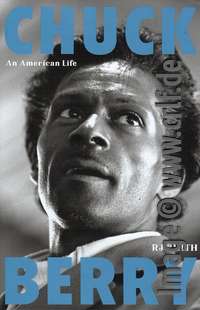
âWhat we have is more interesting. A choice of threading through the details of his life or working around them completely â your call! - and simply hearing him. To pull the joy and poetry out of the music he created and have it take us where it wants to go â not where he went. To live our lives with it, and not live his life. Thatâs a lot.â
As the creators of this website we have made our choice a long time ago. These pages here are about the music of Chuck Berry and only about his music. We do not discuss any other aspects of Berryâs life in this blog or on the main page. For us there were at least two very good reasons for this decision. For one, we are deeply convinced that Berryâs music is much more entertaining than his criminal, sexual and business affairs. And secondly we think that with recordings and records we have at least a small factual base to build our research upon. RJ Smith in his new âChuck Berry: An American Lifeâ decided to concentrate on all the other stuff instead.
Chuck Berry was a control freak, a sex maniac and business-wise everything but a nice person. His criminal records included armed robbery, tax evasion, and what we would call today child abuse, plus many more. All this is no new news. We have read about these in newspapers and books as well as all over the Internet.
RJ Smith quotes Berry saying he wants the people to tell the truth about him. But there are many truths. There is the truth about a strange man with a weird character and perverse habits. But there also is the truth about the musical artist whose output had a huge impact on what became popular music during the last 70 years.
It might have been interesting to discuss Berryâs personality from a psychological perspective. Or it might have been interesting to analyze how this pathological mindset affected Berryâs music or lyrics.
None of this you will find in this book, though. Instead RJ Smith has taken a huge effort to document Berryâs failings. Most has been known before and is documented in detail e.g. in Bruce Peggâs excellent biography. Smith dug even deeper into court documents and he tried to get quotes from witnesses not published before. However, most of the contents is a simple repetition from old sources such as Berryâs own autobiography â even repeating errors included.
Where Smithâs book enhances the previously published biographies is the coverage of Berryâs last years. Thatâs the advantage of a biographer who waits until his subject has deceased. So here we get a few additional pages about his latest tours, the release of his last record, and we learn how his family declared Berry incompetent.
Smith in many aspects tries to write a different biography and succeeds in doing so. He completely concentrates on Berryâs personal and business matters, almost ignoring his musical work. Only for one song Smith reserves a complete chapter: My Ding-A-Ling. And again the author accomplishes something different as this song was left out of any serious discussion about Berryâs Ćuvre so far.
One peculiarity of this text is a bit confusing for European readers: All over the book RJ Smith tries to find arguments to justify Berryâs behavior as a result of black versus white America. As being no part of the American society, we are not qualified to judge on RJâs findings. From a musical point-of-view I think it is a bit far fetched to locate racially related hints in the lyrics of e.g. Promised Land.
Is this a book you want to read? If you love Chuck Berry, donât do it. If you are interested in Chuck Berryâs music, thereâs nothing to gain from reading it. But if you want to learn about Berryâs porn collection or any other aspect of his life, thereâs almost too much information in âChuck Berry: An American Lifeâ. But in the end it definitely is âyour callâ: a choice of threading through the details of his life or working around them completely.
âChuck Berry: An American Lifeâ by RJ Smith (Hachette Books, ISBN 978-0-306-92163-6) is available in every better book store near you.

Posted by Dietmar Rudolph
in Chuck Berry Rarities
at
16:45
| Comment (1)
| Add Comment
| Contact Webmaster
Friday, July 5. 2019
The fifty-five Chuck Berry recordings missing from the Bear Family 16-CD set

Recently an unnamed Chuck Berry fan collected what he called âThe Ultimate Collection of Hard-to-find Rarities, Live Performances, Demos & Out-Takesâ. I donât know who this fan is, but I know for a fact that he/she follows the articles in this blog closely.
Probably, this privately-made collection has been made available on one of the typical bootleg sites. For some time, privately-made CD copies of this collection were sold by an American bootlegger on ebay using the album name âSuch A Sight To See â Vol. 1â. There are other Volumes containing all kinds of live performances. The bootleg CDs have a printing âMade in Japanâ and a barcode (all the same), which are intended to make them look âofficialâ.
We do not encourage to buy bootlegs as we believe that music creators (artists, musicians, studios, labels) deserve a fair compensation for creating the work we all enjoy. However, we would like to encourage Bear Family and similar re-issue labels to take this collection as a pattern of what urgently needs to be re-released soon.
On the first two CDs of this collection, the creator included 55 (53) studio recordings by Chuck Berry. All follow a simple rule: they have been released in the past before but were omitted from the omnibus Rock And Roll Music - Any Old Way You Choose It (Bear Family BCD 17273 PL, 2014). Which tells us that if Bear Family would have included just two more CDs in their 16-CD boxset, theyâd had indeed made the âultimateâ Berry collection.
Many of the tracks are from the out-of-print HIP-O-Select boxsets, some are from other CDs and records and were missing even on these âcompleteâ sets. All have been discussed on this site before. One should note, though, that some of these tracks are omitted from the Bear Family set by intention e.g. because of the poor sound quality (Go Go Go, Top Gear tracks). Anyway, they are âout thereâ and thus missing.
The collectorâs effort in combining the missing recordings is worth to be repeated here for all of you who would like to know what they missed when buying the Bear Family box. Thus here it is (with a few corrections from me):
Congratulations to the collector for this next-to-complete list. Along with the Bear Family set this combines every surviving studio recording ever made by Chuck Berry (except for the late Dualtone release and a couple of TV and radio studio recordings).
Thus a request to Bear Family and the other labels: This is what collectors would like to be able to buy legally!
Probably, this privately-made collection has been made available on one of the typical bootleg sites. For some time, privately-made CD copies of this collection were sold by an American bootlegger on ebay using the album name âSuch A Sight To See â Vol. 1â. There are other Volumes containing all kinds of live performances. The bootleg CDs have a printing âMade in Japanâ and a barcode (all the same), which are intended to make them look âofficialâ.
We do not encourage to buy bootlegs as we believe that music creators (artists, musicians, studios, labels) deserve a fair compensation for creating the work we all enjoy. However, we would like to encourage Bear Family and similar re-issue labels to take this collection as a pattern of what urgently needs to be re-released soon.
On the first two CDs of this collection, the creator included 55 (53) studio recordings by Chuck Berry. All follow a simple rule: they have been released in the past before but were omitted from the omnibus Rock And Roll Music - Any Old Way You Choose It (Bear Family BCD 17273 PL, 2014). Which tells us that if Bear Family would have included just two more CDs in their 16-CD boxset, theyâd had indeed made the âultimateâ Berry collection.
Many of the tracks are from the out-of-print HIP-O-Select boxsets, some are from other CDs and records and were missing even on these âcompleteâ sets. All have been discussed on this site before. One should note, though, that some of these tracks are omitted from the Bear Family set by intention e.g. because of the poor sound quality (Go Go Go, Top Gear tracks). Anyway, they are âout thereâ and thus missing.
The collectorâs effort in combining the missing recordings is worth to be repeated here for all of you who would like to know what they missed when buying the Bear Family box. Thus here it is (with a few corrections from me):
1. La Jaunda (EP Version) â We prefer the spelling La Juanda because this is what Chuck sings.
2. Rock and Roll Music (Alternate Take)
3. Sweet Little Sixteen (Original Demo â Longer Ending) â nowadays considered to be Take 1.
4. Sweet Little Sixteen (Take 3 )
5. Sweet Little Sixteen (Take 8 ) â which in fact is a combination of Take 11 and Take 13.
6. Sweet Little Sixteen (Take 11 )
7. Sweet Little Sixteen (Master â Original Speed)
8. Night Be At (Take 3 ) â correct title is Night Beat, of course.
9. Time Was (Take 4 )
10. Reelinâ And Rockinâ (Take 1 )
11. Reelinâ And Rockinâ (Take 7 )
12. Reelinâ And Rockinâ (Take 8 )
13. Johnny B. Goode (Take 1 )
14. Johnny B. Goode (Take 2 )
15. Johnny B. Goode (Take 3 )
16. Around And Around (Overdub â Take 2 )
17. Around And Around (Overdub â Take 3 )
18. Ingo (Overdub â Take 3 )
19. Beautiful Delilah (Takes 15 & 16 )
20. 21 (Take 14 )
21. Carol (Alternate Piano Overdub 1 )
22. Carol (Alternate Piano Overdub 2 )
23. Anthony Boy (Take 6 )
24. Sweet Little Rock âNâ Roller (Take 5 )
25. Merry Christmas Baby (Album Version)
26. Little Queenie (Take 8 )
27. Do You Love Me (Alternate Take)
28. Almost Grown (Take 14 )
29. Almost Grown (Take 28 )
30. Blue on Blue (Take 3 )
31. Betty Jean (Take 14 )
32. Betty Jean (Take 17 )
33. Childhood Sweetheart (Alternate Take)
34. I Just Want to Make Love to You (Take 3 )
35. Broken Arrow (Take 21 )
36. Let It Rock (Alternate Mix)
37. Too Pooped To Pop (Take 4A )
38. Go Go Go (Alternate Take)
39. Nadine (Stereo Remix)
(40.) The Little Girl From Central (Stereo) â the stereo version IS in the Bear Family box, though.
41. O Rangutang (No Fade)
(42.) Big Ben Blues (Stereo) â likewise also this stereo version is not missing in Bear Familyâs set.
43. Promised Land (Stereo Remix)
44. No Particular Place To Go (Stereo Remix)
45. Little Marie (Stereo Remix)
46. I Want To Be Your Driver (Stereo Remix)
47. Nadine (BBC Top Gear) â these three are from BBC Radio 1965
48. Promised Land (BBC Top Gear)
49. No Particular Place To Go (BBC Top Gear)
50. Oh Captain (Original Unsynched)
51. YMCA Radio Spot
âââ missing here is the NAPRA Radio Spot of 1975
52. Ridinâ Along In My GTI
53. Go Shabba Go (With Shabba Ranks)
54. Independence Air Commercial
55. Independence Air Safety Briefings
Congratulations to the collector for this next-to-complete list. Along with the Bear Family set this combines every surviving studio recording ever made by Chuck Berry (except for the late Dualtone release and a couple of TV and radio studio recordings).
Thus a request to Bear Family and the other labels: This is what collectors would like to be able to buy legally!
Posted by Dietmar Rudolph
in Chuck Berry Rarities
at
13:41
| Comments (0)
| Add Comment
| Contact Webmaster
Tuesday, April 23. 2019
The Chuck Berry On Stage confusion continues

If you followed our discussions about the Chuck Berry On Stage (Chess LP-1480) album, you will understand why there is such a huge confusion about the contents and appearance of this album. Since December 2014 we have been discussing the cover variants of the album showing that none of the images on the net associated with this album represents the original first cover (except for the ones shown on this site).
In December 2017 we added a second discussion about Vinyl variants of this album explaining why almost every description of CHESS LP-1480 includes an incorrect track listing. As the original record was supposed to be taken for a true live recording, it didn't had a track listing on the labels and just a non-ordered song list on the back cover.
Both the song list and the most common US cover include a song title never used by Berry: "Surfin' USA". The Chess brothers were trying to generate sales following the Beach Boys' hit record which indeed was a disguised cover version of Berry's "Sweet Little Sixteen". And following the Surf craze they also re-titled an instrumental originally called "Crying Steel" to become known as "Surfing Steel".
All in all it's no wonder partner record companies who licensed the On Stage album became confused as well. Which in turn again resulted in strange variants of record covers. Of course you need to collect Chuck Berry records as intense as this site's Morten Reff to notice the interesting variations of covers such as these two here:
AUSTRALIA
The Australian version of Chuck Berry On Stage was released as CHESS CHL-211 not long after the US version in 1963. The front cover follows the US version closely except for the boxed CHESS in the upper right corner. The track listing on the back is a variant of the song list from the US album. It correctly distributes the songs to Side 1 and Side 2 but retains the incorrect sequence and naming.
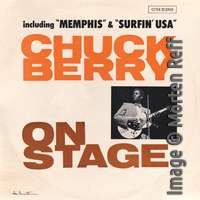
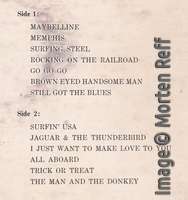
Maybe due to complaints — Hey, I bought Surfin' USA from Chuck Berry but it isn't on the disk! — some time later the company quietly replaced the cover with a slightly corrected version. Now on the front cover "Surfin' USA" became "Maybelline" [sic], and within the track listing "Surfin' USA" became "Sweet Little 16" [sic]. Also the song sequence on Side 1 is now as it is on the record. Since also the Chess logo in the upper right corner changed, this variant may have been released a year or more later.
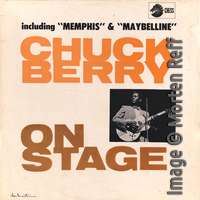
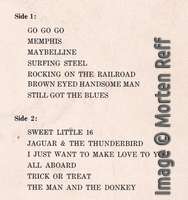
The record itself including the printing on the labels did not change, though. Side 2 still incorrectly lists "Surfin' USA".
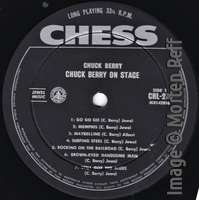
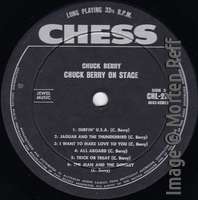
THE NETHERLANDS
In the Netherlands, Berry's Chess records were released by Artone on their Funckler label. They designed their own cover for the On Stage album. When it came out as Funckler MGCH-9218 in March 1964, "Sweet Little Sixteen" already made it to the front cover correctly. However, "Surfin' USA" is still there, this time as an incorrect title for "Cryin'/Surfing Steel". This error is both on the front cover and in the track listing on the back.
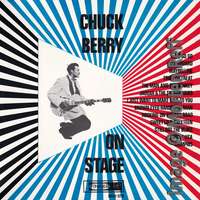
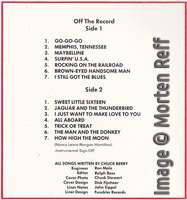
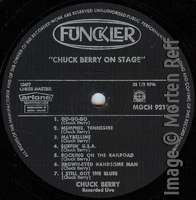
Again, some time later Artone re-released the record. The had now licensed the Chess label name and logo and were releasing the records under the Chess International label. While exchanging the Funckler logo on cover and label, they also corrected the song title. On Chess International PAR-106 "Surfin' USA" was replaced by "Surfin' Steel" (keeping the apostrophe) on both cover and label.
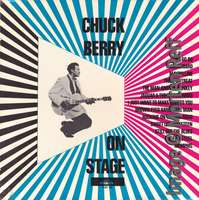
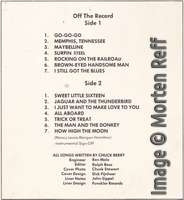
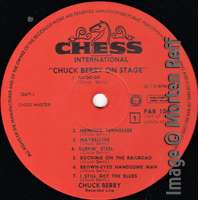
One should note that Artone changed covers, labels and even packaging often. Either they printed too few copies or they sold much more than expected. According to Morten's research, the Funckler version also exists with an orange color label. The Chess International version has the album name printed in red on some copies while it's printed in black on others. Finally PAR-106 exists in a standard LP cover (with spine, open at only one side) as well as in the Artone-typical plastic sleeve. Artone tried to establish selling albums in a clear plastic sleeve which could be used for all LPs unchanged. The cover printing was on a folded thin cardboard open at three sides which was easier and cheaper to produce. Records by all the Artone labels such as Funckler, Prestige and even CBS International were released this way. This kind of packaging did not prevail, though. Even Artone finally came to use the industry standard glued cover.
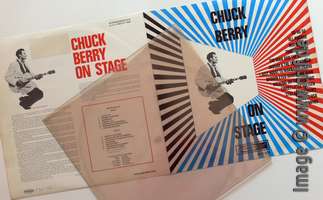
And no, Morten is not sure that he has all the existing variants.
Thanks to Morten for the images and details plus thanks to Arne Wolfswinkel and Frank Jochemsen for background information about the Artone packaging.
In December 2017 we added a second discussion about Vinyl variants of this album explaining why almost every description of CHESS LP-1480 includes an incorrect track listing. As the original record was supposed to be taken for a true live recording, it didn't had a track listing on the labels and just a non-ordered song list on the back cover.
Both the song list and the most common US cover include a song title never used by Berry: "Surfin' USA". The Chess brothers were trying to generate sales following the Beach Boys' hit record which indeed was a disguised cover version of Berry's "Sweet Little Sixteen". And following the Surf craze they also re-titled an instrumental originally called "Crying Steel" to become known as "Surfing Steel".
All in all it's no wonder partner record companies who licensed the On Stage album became confused as well. Which in turn again resulted in strange variants of record covers. Of course you need to collect Chuck Berry records as intense as this site's Morten Reff to notice the interesting variations of covers such as these two here:
AUSTRALIA
The Australian version of Chuck Berry On Stage was released as CHESS CHL-211 not long after the US version in 1963. The front cover follows the US version closely except for the boxed CHESS in the upper right corner. The track listing on the back is a variant of the song list from the US album. It correctly distributes the songs to Side 1 and Side 2 but retains the incorrect sequence and naming.


Maybe due to complaints — Hey, I bought Surfin' USA from Chuck Berry but it isn't on the disk! — some time later the company quietly replaced the cover with a slightly corrected version. Now on the front cover "Surfin' USA" became "Maybelline" [sic], and within the track listing "Surfin' USA" became "Sweet Little 16" [sic]. Also the song sequence on Side 1 is now as it is on the record. Since also the Chess logo in the upper right corner changed, this variant may have been released a year or more later.


The record itself including the printing on the labels did not change, though. Side 2 still incorrectly lists "Surfin' USA".


THE NETHERLANDS
In the Netherlands, Berry's Chess records were released by Artone on their Funckler label. They designed their own cover for the On Stage album. When it came out as Funckler MGCH-9218 in March 1964, "Sweet Little Sixteen" already made it to the front cover correctly. However, "Surfin' USA" is still there, this time as an incorrect title for "Cryin'/Surfing Steel". This error is both on the front cover and in the track listing on the back.



Again, some time later Artone re-released the record. The had now licensed the Chess label name and logo and were releasing the records under the Chess International label. While exchanging the Funckler logo on cover and label, they also corrected the song title. On Chess International PAR-106 "Surfin' USA" was replaced by "Surfin' Steel" (keeping the apostrophe) on both cover and label.



One should note that Artone changed covers, labels and even packaging often. Either they printed too few copies or they sold much more than expected. According to Morten's research, the Funckler version also exists with an orange color label. The Chess International version has the album name printed in red on some copies while it's printed in black on others. Finally PAR-106 exists in a standard LP cover (with spine, open at only one side) as well as in the Artone-typical plastic sleeve. Artone tried to establish selling albums in a clear plastic sleeve which could be used for all LPs unchanged. The cover printing was on a folded thin cardboard open at three sides which was easier and cheaper to produce. Records by all the Artone labels such as Funckler, Prestige and even CBS International were released this way. This kind of packaging did not prevail, though. Even Artone finally came to use the industry standard glued cover.

And no, Morten is not sure that he has all the existing variants.
Thanks to Morten for the images and details plus thanks to Arne Wolfswinkel and Frank Jochemsen for background information about the Artone packaging.
Sunday, April 21. 2019
Stephanie Bennett on the Making of Hail! Hail! Rock 'n' Roll

Stephanie Bennett is a famous film producer having created some of the best rock documentaries. Chuck Berry collectors know her as the producer who brought to us "Hail! Hail! Rock 'n' Roll", the famous concert film and documentary celebrating Berry's 60th birthday.
And while Bennett, director Taylor Hackford, and musical director Keith Richards definitely tried to celebrate Berry in this movie, we all know that Berry's cooperation was less than sufficient. To Berry this was just another business project he got paid for.
Due to this, production of the movie was more than chaotic. Despite of what ended up in the movie, Berry did not help making it, but instead helped to destroy Hackford's and Richards' work and intentions.
Mrs. Bennett says that Berry's passing two years ago brought back all the memories about the creation of this film. While discussing the thirty years old events with their teammates, she decided to write a book about this once-in-a-lifetime experience. Now the book is out, published by Vireo/Rare Bird Books in the U.S. and available through all bookstores. It is called "Johnny B. Bad — Chuck Berry and the Making of Hail! Hail! Rock 'n' Roll", 220 pages thick, hardcover bound and including a selection of color photographs.
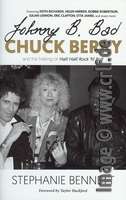
The title page says "written by Stephanie Bennett" while the inner page says "written by Stephanie Bennett with Thomas D. Adelman" who was the line producer of the movie. In fact, the book wasn't written by either. Mrs. Bennett calls her book an 'oral history'. This means it is a collection of quotes of what the team members remember from the movie production.
Tom Adelman remembers a lot, so does Stephanie Bennett. But most of the quotes are old. There's a two-page quote by Bruce Springsteen about backing up Berry one time. But this isn't a new quote from an interview done for this book. It is word-for-word in the movie itself.
Most of the readers here will own the DVD version of the movie. Most will own the 2006 two-DVD set or even, as recommended here, the four-DVD set containing all the bonus material. And if you own these DVDs, you already know most of the quotes.
For instance the first chapter is a "conversation with Chuck Berry and Robbie Robertson". And this is a word-for-word transcription of the half-hour film "The Burnt Scrapbook — Robbie Robertson and Chuck Berry's Scrapbook" which is on DVD 3. (Unfortunately typed by someone who didn't watch the film, as Chuck Berryn becomes Chuck Barron in the book.)
Chapter two is "Chuck Berry, Bo Diddley & Little Richard" and — you guessed it — is a word-for-word transcription of the 90-minute "Witnesses to History #1" which is also on DVD 3. Thus while you have reached page 56 of the book, all you got is that someone read to you the contents of DVD 3.
Most stories told and many, many of the other quotes are taken from "The Reluctant Movie Star — The bizarre tales of the making of Hail! Hail! Rock 'n' Roll" which is a one-hour film on DVD 2 of the set. This includes both the Algoa incident and the concert recording memories.
Of course there also is original material in the book. Especially the story about the team checking out Berry's performance at the Chicago Blues Festival (where Richards performed with Berry), the stories about the visit to Richards' home in Jamaica, and the things that happened after the shooting of the movie haven't been told yet, at least not to this detail. Unfortunately the original material is less than half of the book.
To those who are purely interested in the musical aspects of Berry's work, there is a single page which is of interest. In between the nice color photo section you'll suddenly find a one-page type-written sheet called "Song Selection".
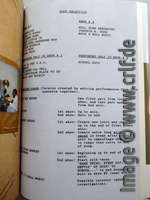
On this page we get an exact description of the songs which made it into the movie. This includes the show number they were taken from. And it includes a list of those "recordings" which have been combined from the performances in show one and show two.
Another interesting fact from the book is that the concert recordings have been overdubbed twice. There was one overdub session at Berry Park where Billy Youdelman re-recorded some of the vocals for the movie's audio track. And there was a second overdub session in which Don Wershba re-recorded some of the vocals for the soundtrack album. (This is why we get two different vocal overdubs for "Roll Over Beethoven".) Trying to further fill the missing pieces in our database I asked Mrs. Bennett, Mr. Youdelman, and Mr. Wershba whether they have any notes left telling about the dates and places of the overdubs. All three were so kind to reply to my inquiry but unfortunately Mrs. Bennett has no paperwork regarding these topics. Billy Youdelman cannot remember the exact date but that it was shortly after the concert and that it was only a one or two day job, and not very long. Don Wershba's memories are worth another blog entry due soon.
Whether you will want to buy the book depends on your preference of reading vs. watching DVDs. And of course on whether you own the DVDs. It's a nice read, but as said, it's old news. Many of the quotes you will have heard before. Some of the newly told anecdotes, especially by Hackford, Bennett and Adelman, might be worth the price of the book, though. And if you wonder why actress Helen Mirren comments on the story as if she was part of the movie, keep in mind that she is married to Taylor Hackford and accompanied him throughout the making of this film.
Do not miss to visit the book's own website johnnybbadbook.com. It contains a lot of interesting photos as well as videos with Hackford and Bennett telling some of the stories.
Many thanks to Julia Callahan of Rare Bird Books, Stephanie Bennett, Billy Youdelman, and Don Wershba for answering my additional questions.
And while Bennett, director Taylor Hackford, and musical director Keith Richards definitely tried to celebrate Berry in this movie, we all know that Berry's cooperation was less than sufficient. To Berry this was just another business project he got paid for.
Due to this, production of the movie was more than chaotic. Despite of what ended up in the movie, Berry did not help making it, but instead helped to destroy Hackford's and Richards' work and intentions.
Mrs. Bennett says that Berry's passing two years ago brought back all the memories about the creation of this film. While discussing the thirty years old events with their teammates, she decided to write a book about this once-in-a-lifetime experience. Now the book is out, published by Vireo/Rare Bird Books in the U.S. and available through all bookstores. It is called "Johnny B. Bad — Chuck Berry and the Making of Hail! Hail! Rock 'n' Roll", 220 pages thick, hardcover bound and including a selection of color photographs.

The title page says "written by Stephanie Bennett" while the inner page says "written by Stephanie Bennett with Thomas D. Adelman" who was the line producer of the movie. In fact, the book wasn't written by either. Mrs. Bennett calls her book an 'oral history'. This means it is a collection of quotes of what the team members remember from the movie production.
Tom Adelman remembers a lot, so does Stephanie Bennett. But most of the quotes are old. There's a two-page quote by Bruce Springsteen about backing up Berry one time. But this isn't a new quote from an interview done for this book. It is word-for-word in the movie itself.
Most of the readers here will own the DVD version of the movie. Most will own the 2006 two-DVD set or even, as recommended here, the four-DVD set containing all the bonus material. And if you own these DVDs, you already know most of the quotes.
For instance the first chapter is a "conversation with Chuck Berry and Robbie Robertson". And this is a word-for-word transcription of the half-hour film "The Burnt Scrapbook — Robbie Robertson and Chuck Berry's Scrapbook" which is on DVD 3. (Unfortunately typed by someone who didn't watch the film, as Chuck Berryn becomes Chuck Barron in the book.)
Chapter two is "Chuck Berry, Bo Diddley & Little Richard" and — you guessed it — is a word-for-word transcription of the 90-minute "Witnesses to History #1" which is also on DVD 3. Thus while you have reached page 56 of the book, all you got is that someone read to you the contents of DVD 3.
Most stories told and many, many of the other quotes are taken from "The Reluctant Movie Star — The bizarre tales of the making of Hail! Hail! Rock 'n' Roll" which is a one-hour film on DVD 2 of the set. This includes both the Algoa incident and the concert recording memories.
Of course there also is original material in the book. Especially the story about the team checking out Berry's performance at the Chicago Blues Festival (where Richards performed with Berry), the stories about the visit to Richards' home in Jamaica, and the things that happened after the shooting of the movie haven't been told yet, at least not to this detail. Unfortunately the original material is less than half of the book.
To those who are purely interested in the musical aspects of Berry's work, there is a single page which is of interest. In between the nice color photo section you'll suddenly find a one-page type-written sheet called "Song Selection".

On this page we get an exact description of the songs which made it into the movie. This includes the show number they were taken from. And it includes a list of those "recordings" which have been combined from the performances in show one and show two.
Another interesting fact from the book is that the concert recordings have been overdubbed twice. There was one overdub session at Berry Park where Billy Youdelman re-recorded some of the vocals for the movie's audio track. And there was a second overdub session in which Don Wershba re-recorded some of the vocals for the soundtrack album. (This is why we get two different vocal overdubs for "Roll Over Beethoven".) Trying to further fill the missing pieces in our database I asked Mrs. Bennett, Mr. Youdelman, and Mr. Wershba whether they have any notes left telling about the dates and places of the overdubs. All three were so kind to reply to my inquiry but unfortunately Mrs. Bennett has no paperwork regarding these topics. Billy Youdelman cannot remember the exact date but that it was shortly after the concert and that it was only a one or two day job, and not very long. Don Wershba's memories are worth another blog entry due soon.
Whether you will want to buy the book depends on your preference of reading vs. watching DVDs. And of course on whether you own the DVDs. It's a nice read, but as said, it's old news. Many of the quotes you will have heard before. Some of the newly told anecdotes, especially by Hackford, Bennett and Adelman, might be worth the price of the book, though. And if you wonder why actress Helen Mirren comments on the story as if she was part of the movie, keep in mind that she is married to Taylor Hackford and accompanied him throughout the making of this film.
Do not miss to visit the book's own website johnnybbadbook.com. It contains a lot of interesting photos as well as videos with Hackford and Bennett telling some of the stories.
Many thanks to Julia Callahan of Rare Bird Books, Stephanie Bennett, Billy Youdelman, and Don Wershba for answering my additional questions.
Tuesday, January 8. 2019
Vinyl variants of CHESS LP-1480 'Chuck Berry On Stage'

Some time ago this blog had a large article on cover variants of the album Chuck Berry On Stage (Chess LP-1480). I had promised a follow-up on Vinyl variants of this album and because a recent discussion with a reader showed that most information about this album floating around on the Net is incorrect, here it comes.
Letâs start with some background information: From early 1962 to late 1963 Chuck Berry was behind bars. Berryâs previous records sold poorly due to his trials. During his prison stay he was not allowed to record new material in the studios. His record company CHESS only had a small stock of unreleased recordings.
Thus the record company was caught cold when new bands on both sides of the Atlantic became successful by covering Berry material. The Beach Boys' Surfinâ USA was released in March 1963, the Stonesâ version of Come On in June. Memphis was a hit by Lonnie Mack and the Beatles had several Berry songs in their repertoire.
There was an urgent need for a new Berry album, but there was nothing to put on it. The Chess brothers dug through their archives and looked for unreleased material recorded during the previous years. They found four tracks recorded August 1961 which they considered worth for release: Trick or Treat, The Man And The Donkey, All Aboard, and a re-recording of Brown Eyed Handsome Man. Two recordings were left from an April 1960 session: Crying Steel and I Still Got The Blues. And there was I Just Want To Make Love To You recorded in July 1959. These seven songs were selected. Today we know that there were other unreleased recordings such as House Of Blue Lights, Time Was, 21 Blues, Oh Yeah, Do You Love Me, Iâm Just A Lucky So And So, or Adulteen. None was regarded as appropriate by the studio bosses, though.
Seven songs are not enough for an album and none of it was good enough for a single. So what to do?
The Chess brothers were known for their creativity so they came up with a creative solution. Why not fill the album with older material released some years ago? OK, they already did a Greatest Hits album called Chuck Berry Twist in 1962. But why not change the hits a little bit so nobody notices?
Letâs use different song titles and letâs add some audience noise to make the album sound like it was recorded live!
I have done studio albums that ultimately sounded like "live" albums. We did a "live" Chuck Berry album, and the world didn't know that Chuck Berry was in jail at that time. We actually were releasing previously unreleased tapes that were in the can. Then we thought we'd come up with a remote which would let us release old tunes that were supposedly "live". So I found the original takes with the count-offs and the dumb endings and everything else, and I cut it all together and created a performance. Then we sweetened it, but the audience sounded phony. However, the Beatles were doing some concerts during the same time period, and the kids were screaming all the way through their concerts. So I used those audience screams, and had a continuous roar during the whole album ... at the end it got real loud. I even had the audience singing with Chuck Berry — if you ride the control along with the words it sounds like the audience's reaction is singing the words. [Ron Malo, Modern Recording & Music, Vol. 6, No. 12, Sept. 1981, p. 58]To disguise this fake even more, the Chess brothers asked Rodney Jones, who was a DJ with the Chess-owned WVON radio station, to add a little introduction. So Jones proudly announces âWelcome to the Tivoli Theatre here in Chicago ...â
The editing and engineering work to add the fake applause and Jonesâ shouts must have been done by Ron Malo sometime in May 1963. The two album sides were mastered from the resulting tape by the end of May or beginning of June and received the Chess master numbers 12477 (side 1, 16â25â) and 12478 (side 2, 14â14â).
Not telling anyone about the fake nature of this album, the liner notes proudly lied:
On this LP we present the world famous Chuck Berry in a jumping, in-person theatre appearance with thousands of fans enthusiastically responding to Chuckâs great performance. Any performer will tell you that he prefers to record in front of a live audience. There is nothing like the cheers and applause of an audience to spur a performer on to the heights of his ability and Chuck really gives his all in front of this packed theatre.
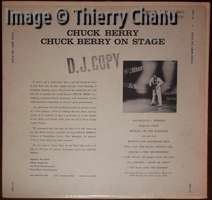
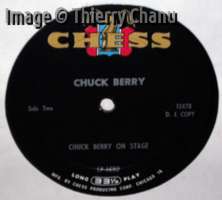
To completely confuse the buyers, the album came without a track listing. The back cover has a non-ordered and incomplete list of songs contained (and the image of an eight-year old LP). The labels simply say Side One and Side Two without any song titles at all. This obfuscation has resulted in incorrect track listings on the Net. Despite everything you read on discogs or wikipedia, the contents of the original US album Chuck Berry On Stage, released in August 1963 as CHESS LP-1480, is as follows:
Side 1:
- Introduction by Rodney Jones
- Go Go Go â originally released in 1961 on CHESS 1799 b/w Come On
- Memphis, Tennessee (title shortened to Memphis) â originally released in 1959 on CHESS 1729 b/w Back in the USA
- Maybellene (now written as Maybelline) â originally released in 1955 on CHESS 1604 b/w Wee Wee Hours
- Crying Steel (here named Surfing Steel) â finally released less overdub in 1988
- Let It Rock (renamed to Rocking On The Railroad) â originally released in 1960 on CHESS 1747 b/w Too Pooped To Pop
- Brown Eyed Handsome Man â finally released less overdub in 1979
- I Still Got The Blues (as Still Got The Blues) â finally released less overdub in 1993
Side 2:
- Sweet Little Sixteen (renamed to Surfinâ USA) â originally released in 1958 on CHESS 1683 b/w Reelinâ And Rockinâ
- Jaguar And The Thunderbird â originally released in 1960 on CHESS 1767 b/w Our Little Rendezvous
- I Just Want To Make Love To You â finally released less overdub in 1993
- All Aboard â finally released less overdub in 2003
- Trick Or Treat â finally released less overdub in 2009
- The Man And The Donkey â finally released less overdub in 1974
- How High The Moon â finally released less overdub in 1979
How High The Moon is a 1940s jazz standard. The version heard here has been recorded during a May 1957 session. Chuck Berry, Willie Dixon, Lafayette Leake and Fred Below probably used it as an instrumental warm-up.
On CHESS LP-1480 the recording is not listed on the cover and used as an instrumental sign-off (as such named on the Dutch albums). Again Rodney Jones was overdubbed to shout âChuck Berry! Chuck Berry! Chuck Berry!â during the first seconds. Shortly thereafter and almost with the first notes from Berryâs guitar, the song fades after 1:03 minutes.
Copies of the original master disk 12477/12478 went to partner companies all over the world and were used to create variants of LP-1480 e.g. in Canada, in Australia, in the Netherlands (note that the Funckler version misprints Surfing Steel as Surfinâ USA), and as re-issues e.g. in Germany (on Bellaphon in 1974) or the only available CD version which was released in Japan (on Universal in 2010).
Of interest to record collectors are variations of the Chuck Berry On Stage album which are not exact copies of the original master disks.
For some reason the UK version, released in October 1963 on PYE international, has not been produced from the LP-1480 master disks. Instead this album must have been created from the original master tapes. Where Side 2 was faded at 14â14â in the US, the British producers found additional space so the second side of PYE NPL-28027 lasts 14â56â instead. Here How High The Moon is 1â45â in contrast to the 1â03â on the CHESS LP.
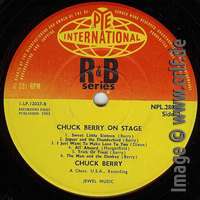
This longer fade is also on the 1970s US orange/blue re-issue LPS-1480. The LPS version has been electronically altered to sound like stereo. To create this âenhancedâ variant CHESS/GRT modified the original longer tape and created a new master called 12477_S/12478_S.
Likewise the 1964 variant released in East Asia (Japan and Taiwan) was created from the longer master tape since How High The Moon has the longer fade here as well. There is a huge difference, though. The East Asian versions miss the instrumental Surfing Steel completely! The song was removed from the tape giving a smooth transition from Maybellene to Let It Rock.
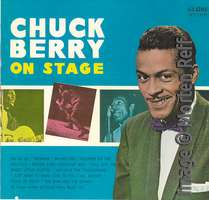
We can only speculate why this was done. Maybe the tape sent to Japan was damaged, maybe there was a company or legal rule not to include instrumentals, or maybe Surfing Steel would translate to bad language in Japanese â pure speculation as said. Or maybe it had to do with the liner notes on the US cover saying
We guarantee that you wonât be able to sit still when you put this album on your turntable and hear Chuck Berryâs versions of Maybelline, Surfinâ USA, Memphis, All Aboard, Trick or Treat and seven other numbers.So the Japanese took this literally and reduced the thirteen track album to twelve numbers. Note aside: The British could count and changed the word seven to eight on the PYE release.
Another interesting aspect of the Japanese release is the corrected track listing on the back cover. The printed cover has a track listing which follows the incorrect list on the US cover, i.e. Go Go Go after Rockin' On The Railroad. This fault was repaired using a yellow sticker which lists the correct track order. The initial Japanese records, probably those used as promo copies, came with a white Imperial label and a thin sticker through which you can see the original print. Later records then had a Globe label and an opaque sticker.
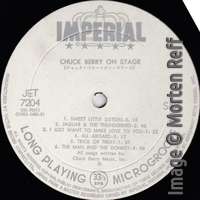
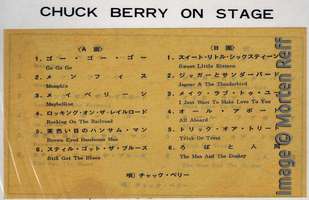
In 1982 the On Stage album was re-issued in Germany as part of a 2 LP set along with Rockinâ At The Hops. This version has Surfing Steel but omits How High The Moon completely.
And finally thereâs the most interesting French version, released on Barclay 80258 in March 1965 as Chuck Berry A L'Olympia. This variant of Chuck Berry On Stage contains the same recordings in the same sequence, though without the two songs having Rodney Jones overdubbed: Go Go Go and How High the Moon were cut off. Instead the French had their own announcer. Eddy Mitchell, a successful RockânâRoll singer by himself, is heard with a French language introduction to side 1 which then starts into Memphis, Tennessee. And Chuck Berry himself speaks the introduction to side 2. In addition a few shouts and stage banter from Berry is merged in between the songs on the tape. Berry refers to Paris and tries to speak French. Both Eddy Mitchellâs introduction and Berryâs segments have been recorded at a Paris concert on February 7, 1965. So this is Chuck Berry on stage, indeed. Just the songs are the same as on the US version having the fake audience.
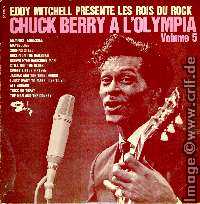
As always: Many thanks to Thierry Chanu and Morten Reff for providing images and a lot of additional information about the 'Chuck Berry On Stage' album.
[Edit 08-01-2018: Added comment and images for the Japanese sticker version.]
[Edit 08-01-2019: Added Ron Malo quote.]
Posted by Dietmar Rudolph
in Chuck Berry Rarities
at
14:35
| Comments (0)
| Add Comment
| Contact Webmaster
Tuesday, October 23. 2018
Nadine - in color - by Jean-C. Denis

As you know, this site is about the music of Chuck Berry and how it was released to the public on records and CDs. Most newer CD releases do not get any mention here because they all contain the same stuff over and over in small variations. It does not make any sense for you to buy any of the re-re-re-releases or samplers. It doesn't make any sense for me either, which is why I do not buy those. We let you know if some re-release is of certain interest, though.
A couple of weeks ago I received a 2017 release which you might want to know about. Again this contains two CDs containing songs you have heard a thousand times. It's just the old Chess records one more time. No need to even listen to those.
But this release is a bit more. "Chuck Berry - Is It You?" (BDROCK BDR144) is a hardcover booklet twice the size of a CD. The two CDs include a total of 44 of his best Chess tracks up until Nadine.
Nadine is also the main point of the book. A seventeen-page comic strip ("Bande Dessinée") shows Berry chasing Nadine following exactly the lyrics of the song. The French text in the drawings is a translation of the lyrics. The drawings were made by Jean-Claude Denis, a well-known comics artist whose publications range back to the late 1970s. Non-french readers should be aware that comics in France, Belgium and other French-speaking countries are considered a special art form. It's not just the funny Snoopy cartoons English-language readers will know. BDs cover serious topics and are usually read by adults, not kids.
As such the Nadine story is drawn the way Berry sings it: seriously with a special kind of humor. Inserted in the story are five full-page drawing showing the ageing Berry in concerts, each drawn according to a typical photo we all know.
The comic strip ends with a full page containing the English lyrics of the song. Next is a "biography", 11 pages in French followed by 11 pages in English. There's little biographical information but more a chronological description of the songs on the CD. It concentrates on the influence of the songs by listing lots of cover versions, especially the French ones.
Finally there's a two-page "discography" which is just the track listing with personnel included. Unfortunately, that info is from very old sources such as the Red Box or the Golden Decade Vol. 2 and is mostly outdated. Please refer to this site's database for the correct recording information.
While you won't care much about the CDs and the "biography", the comic strip and the drawings are quite interesting. Of all the re-releases, this one is special and nice to have.
When looking for this item, check out multiple online shops to find the best price. Amazon Germany for instance demanded almost three times the amount to be paid at Amazon France - at the same shipping costs.
A couple of weeks ago I received a 2017 release which you might want to know about. Again this contains two CDs containing songs you have heard a thousand times. It's just the old Chess records one more time. No need to even listen to those.
But this release is a bit more. "Chuck Berry - Is It You?" (BDROCK BDR144) is a hardcover booklet twice the size of a CD. The two CDs include a total of 44 of his best Chess tracks up until Nadine.
Nadine is also the main point of the book. A seventeen-page comic strip ("Bande Dessinée") shows Berry chasing Nadine following exactly the lyrics of the song. The French text in the drawings is a translation of the lyrics. The drawings were made by Jean-Claude Denis, a well-known comics artist whose publications range back to the late 1970s. Non-french readers should be aware that comics in France, Belgium and other French-speaking countries are considered a special art form. It's not just the funny Snoopy cartoons English-language readers will know. BDs cover serious topics and are usually read by adults, not kids.
As such the Nadine story is drawn the way Berry sings it: seriously with a special kind of humor. Inserted in the story are five full-page drawing showing the ageing Berry in concerts, each drawn according to a typical photo we all know.
The comic strip ends with a full page containing the English lyrics of the song. Next is a "biography", 11 pages in French followed by 11 pages in English. There's little biographical information but more a chronological description of the songs on the CD. It concentrates on the influence of the songs by listing lots of cover versions, especially the French ones.
Finally there's a two-page "discography" which is just the track listing with personnel included. Unfortunately, that info is from very old sources such as the Red Box or the Golden Decade Vol. 2 and is mostly outdated. Please refer to this site's database for the correct recording information.
While you won't care much about the CDs and the "biography", the comic strip and the drawings are quite interesting. Of all the re-releases, this one is special and nice to have.
When looking for this item, check out multiple online shops to find the best price. Amazon Germany for instance demanded almost three times the amount to be paid at Amazon France - at the same shipping costs.
Posted by Dietmar Rudolph
in Chuck Berry Rarities
at
11:52
| Comments (0)
| Add Comment
| Contact Webmaster
Thursday, April 5. 2018
Jimmy Marsala's biased memories of Chuck

Since the late 1970s Chuck Berry traveled to shows domestic and overseas with his friend and bass player James "Jimmy" Marsala. Marsala acted as the band leader performing sound checks and instructing the keyboarder and drummer, often locals, on how to play when sharing the stage with Berry.
Now Marsala has written a book called "Memories of Chuck" in which he reports his experiences on the road.
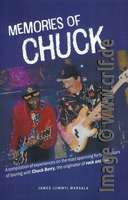
Marsala's recollections could probably have made this a highly interesting book. Unfortunately they didn't. Given the reports from promoters and journalists about Berry's habits regarding payments or female fans, one would expect nice stories from a first-hand witness. Unfortunately the result is tame and boring.
Marsala tries to correct the public image of Berry by defending him in every way. For every incident reported, Marsala finds a probable and nice explanation, whether on leaving a promoter with paid rooms to get a different hotel, or sending the band off-stage, or overrunning fans with a rental car. All of Marsala's stories are so biased you are tempted to stop reading after one third of the book. Only in the very end you'll find a chapter on Berry's "thriftiness". Everyone else would probably call it "closefistedness". Seems as if Marsala in the end did not really liked to sleep on the floor only because Berry decided to book just a single and single-bed hotel room for the two.
Besides two chapters containing short anecdotes of Marsala's life with Berry, the book chronologically describes incidents on various shows and tours between 1979 and 2014. There are five pages about Berry/Marsala's performance at Bill Clinton's inauguration party, five pages about a show in Spain, five pages about a tour in Brazil, and so on. Everything is very brief. Of the 180 pages of the book, only about 100 contain text at all.
Most of the remaining pages contain color(!) photos from Marsala's collection. Most show Marsala and Berry on stages all over the world, or they show Marsala and the band waiting for transportation. Other photos show Berry or Marsala with other famous artist such as Ray Charles, Aretha Franklin or Bill Wyman. Unfortunately many of the photos are not of best quality.
As Marsala writes from a first-hand witness position, we are supposed to believe what we read. You should take into account that Marsala writes from memory, though. And memory may not always be trusted. I cannot judge on most of the anecdotes reported, but I have been on-site at the 1983 Eindhoven concert. This is where the Berry photo from this site's logo originated. In 1983 I wrote about this concert and what I wrote does not necessarily match Marsala's memories.
I wish Marsala would have taken the time to write more, to write more professionally and to write more openly. Then this could have been a very good book. As it is, you will still want to buy a copy, but like me you will be disappointed.
Since none of the larger publishers seems to have been interested in selling this book, Marsala published it on his own using a Canadian company called FriesenPress. This is not a publisher but a company who offers self-publishing. Marsala provided the complete book, probably along with the non-professional layout. FriesenPress stores the book's electronic file and prints a copy as soon as a buyer wants one. They work together with sellers such as amazon and even with local book-on-demand companies for fats supply. When I ordered my copy from amazon Germany, the paperback I got was printed on demand by a German company. Yours may come from some place completely different. Some sellers are listed here.
Now Marsala has written a book called "Memories of Chuck" in which he reports his experiences on the road.

Marsala's recollections could probably have made this a highly interesting book. Unfortunately they didn't. Given the reports from promoters and journalists about Berry's habits regarding payments or female fans, one would expect nice stories from a first-hand witness. Unfortunately the result is tame and boring.
Marsala tries to correct the public image of Berry by defending him in every way. For every incident reported, Marsala finds a probable and nice explanation, whether on leaving a promoter with paid rooms to get a different hotel, or sending the band off-stage, or overrunning fans with a rental car. All of Marsala's stories are so biased you are tempted to stop reading after one third of the book. Only in the very end you'll find a chapter on Berry's "thriftiness". Everyone else would probably call it "closefistedness". Seems as if Marsala in the end did not really liked to sleep on the floor only because Berry decided to book just a single and single-bed hotel room for the two.
Besides two chapters containing short anecdotes of Marsala's life with Berry, the book chronologically describes incidents on various shows and tours between 1979 and 2014. There are five pages about Berry/Marsala's performance at Bill Clinton's inauguration party, five pages about a show in Spain, five pages about a tour in Brazil, and so on. Everything is very brief. Of the 180 pages of the book, only about 100 contain text at all.
Most of the remaining pages contain color(!) photos from Marsala's collection. Most show Marsala and Berry on stages all over the world, or they show Marsala and the band waiting for transportation. Other photos show Berry or Marsala with other famous artist such as Ray Charles, Aretha Franklin or Bill Wyman. Unfortunately many of the photos are not of best quality.
As Marsala writes from a first-hand witness position, we are supposed to believe what we read. You should take into account that Marsala writes from memory, though. And memory may not always be trusted. I cannot judge on most of the anecdotes reported, but I have been on-site at the 1983 Eindhoven concert. This is where the Berry photo from this site's logo originated. In 1983 I wrote about this concert and what I wrote does not necessarily match Marsala's memories.
I wish Marsala would have taken the time to write more, to write more professionally and to write more openly. Then this could have been a very good book. As it is, you will still want to buy a copy, but like me you will be disappointed.
Since none of the larger publishers seems to have been interested in selling this book, Marsala published it on his own using a Canadian company called FriesenPress. This is not a publisher but a company who offers self-publishing. Marsala provided the complete book, probably along with the non-professional layout. FriesenPress stores the book's electronic file and prints a copy as soon as a buyer wants one. They work together with sellers such as amazon and even with local book-on-demand companies for fats supply. When I ordered my copy from amazon Germany, the paperback I got was printed on demand by a German company. Yours may come from some place completely different. Some sellers are listed here.
Monday, December 4. 2017
Cover and label variants of CHESS LP-1480 'Chuck Berry On Stage'

[This article first appeared here on December 16, 2014. Just recently Thierry Chanu found yet another cover variant of LP-1480. Therefore I re-post this blog entry with Thierry's addition edited in below.]
[Now that was fast: A week ago we proudly presented our finding of the very rare sticker version of CHESS LP-1480. And we asked some questions which this finding opened. Immediately I received several emails from our French reader Thierry Chanu which not only answered our open questions but also contributed much much more. Thus we have to re-write the story of 'Chuck Berry On Stage'.]
When you read about the 'Chuck Berry On Stage' album released as CHESS LP-1480 in August 1963, such writing often comes with a photo of the album cover looking like this:
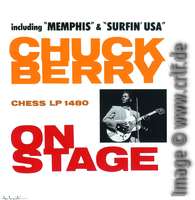
This is typically considered to be the original cover of CHESS LP-1480. As such for instance it was used for the Japanese mini-LP replica Universal Music Japan UICY-94630 we wrote about in October 2010.
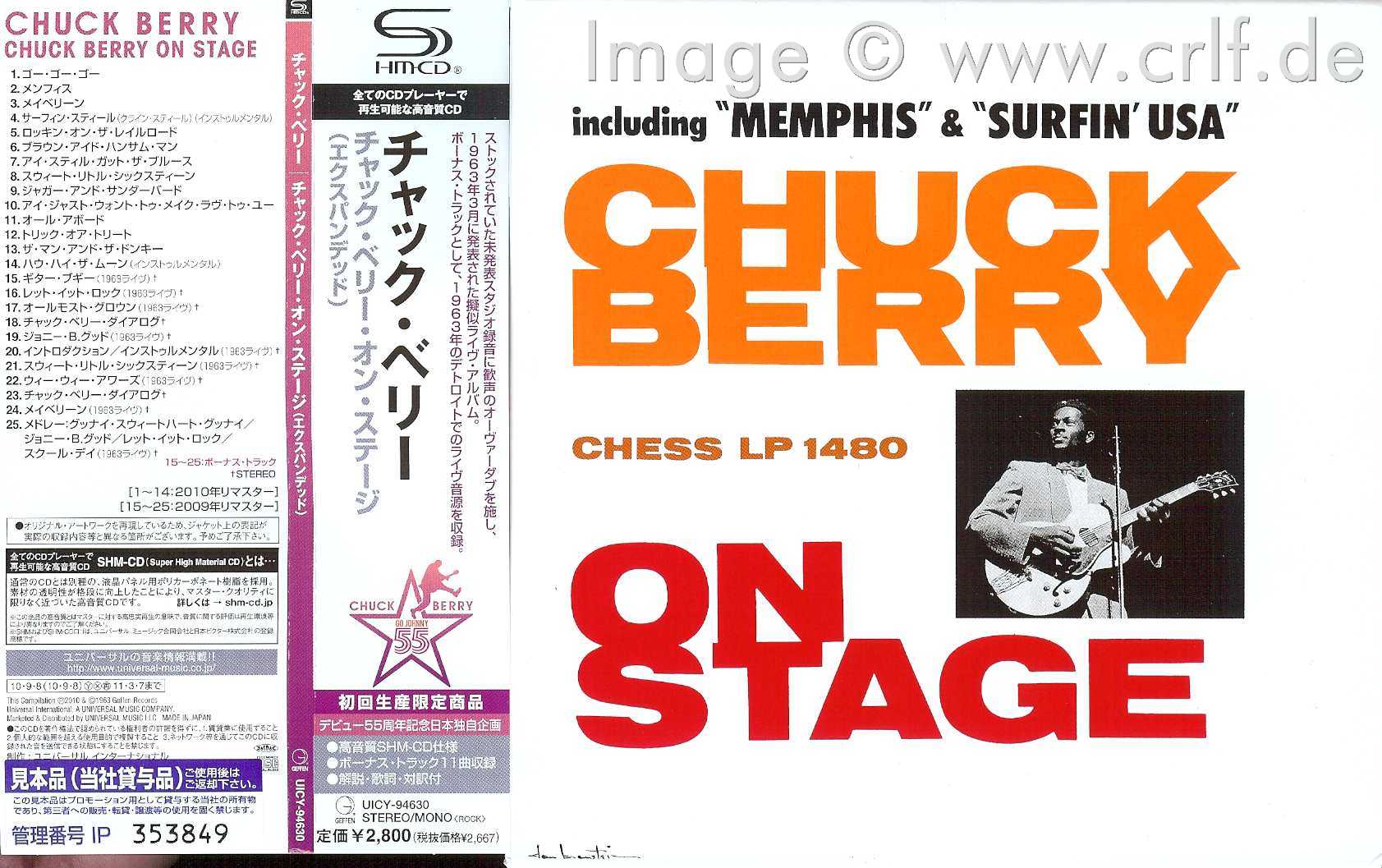
While this is the best known cover for this album and certainly is the variant sold most often, it is not necessarily the 'original' album cover — if you define 'original' as the first version of this cover.
The interesting thing to look at is the line saying including "MEMPHIS" & "SURFIN' USA" above the artist name. It is printed in black letters and refers to the then current famous cover versions of Memphis, Tennessee and Sweet Little Sixteen (as Surfin' USA).
When Morten Reff described Berry's seventh CHESS album on page 60 in his Chuck Berry International Directory, Volume 1, he noted:
The original pressings of this LP had a sticker on the front cover saying 'Including "MEMPHIS" & "SURFIN' USA"'.
Thus there was no printing, just a sticker containing the same wording as the printed text, though 'Including' is written with a capital I. The text on the sticker is in blue instead of black and it uses a different font.
The sticker version is very rare. We were happy to finally get one and we proudly presented it here last week. (Click for a higher resolution image.)
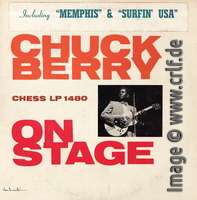
A contemporary ad from Chess showed a black and white image of the sticker version of the album. And the sticker seems to be applied hastily just before the photo shooting as crooked as it is.
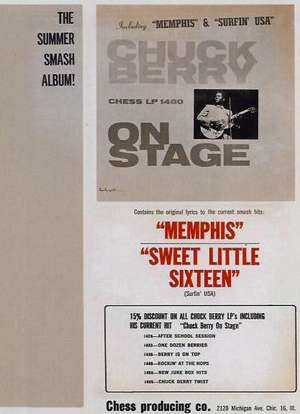
Thierry Chanu then wrote that he as well has a version of this album having the sticker. Though his has been sent out as a promotional advance copy to DJs and marked as such. Here's the back of Thierry's copy:
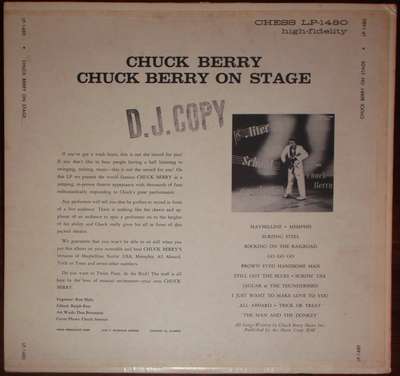
Given that the sticker is both on the advertisement and on the advance copies, we can state that the sticker version existed before the printed version. It must have been commercially available as well, since Morten's copy is not a promotional one.
[Addition 04-12-2017:
There seem to have been two variants of this sticker. The images above show that the sticker contains just the incorrect song title "Surfin' USA". There's a second version of the sticker which adds the correct song title "Sweet Little Sixteen" in small print below "Surfin' USA". Here's a photo of the second sticker version:
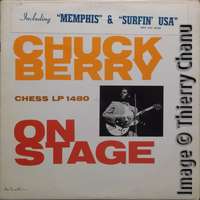
end addition.]
What may be under the sticker, we then asked, as it would be logical that there was no printed text there. So last week we wrote this request to all Chuck Berry collectors reading this site:
Do you have a copy of CHESS LP 1480 which has no sticker and no printing of the 'including' text? If you do, send us an image and we would be happy to show it here.
Again Thierry:
Yes, the cover exists without the sticker. I have one and the record label is black with the golden CHESS on top. It has the same label, writing, and matrix as the DJ copy.
Here's the proof from Thierry's collection:
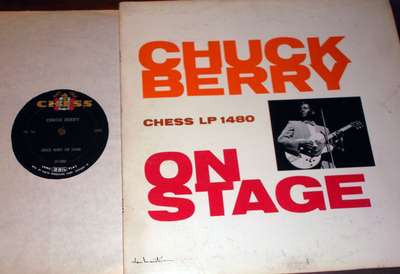
The second part of Thierry's reply refers to the other question we had wondered about: When receiving the sticker version album, Morten had found
"The copy I bought features the second label, the black label (repress) image on page 60."
Thierry's two records make clear that the label with the golden logo is not from a later re-pressing such as Morten's book had suggested. Obviously this is the original label (left: non-sticker version, right: DJ copy), at least for the early copies.
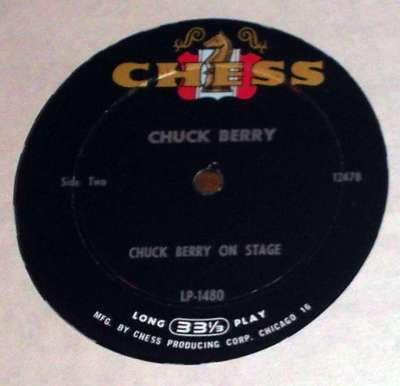
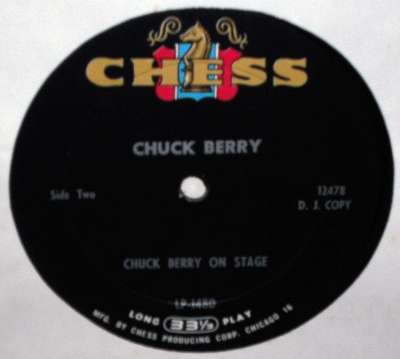
As this was the brand-new CHESS label containing the new multi-colored logo, it's safe to assume that CHESS wanted at least the DJs see this new logo and label. Thierry however makes clear that one has to be careful to distinguish CHESS records just by their label into 'original' and 'later' pressings.
Chess used three or four pressing plants at the same time, so we can find an original record with different labels.
These are additional early labels of CHESS LP-1480. All came in the third variant of the cover, i.e. the one with the printed text. Even though these look like earlier CHESS labels, we probably shall regard them as used interchangeably at the same time.
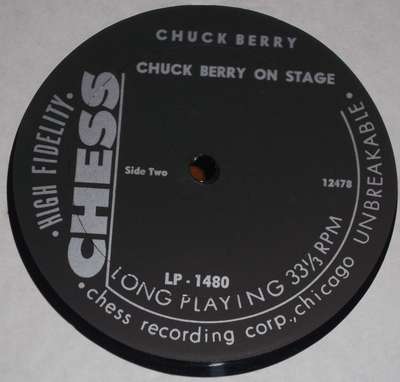
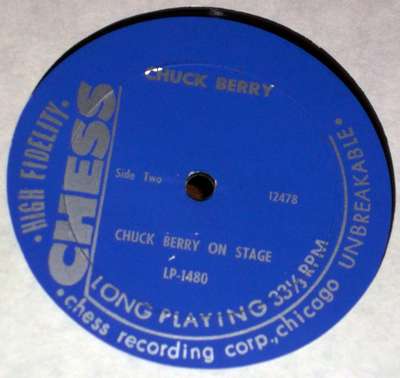
Once more Thierry:
Here's one more regular copy with the black label and vertical Chess logo (different than the other black). This one though has been pressed using a different matrix. It was pressed by the Monarch pressing plant in July 1963. This can be told by the etching located in the run-off (dead wax) area of the record. The Monarch pressing plant is identified by an MR inside a circle, always in the trail-off area. The numbers following this symbol tell the date of mastering.
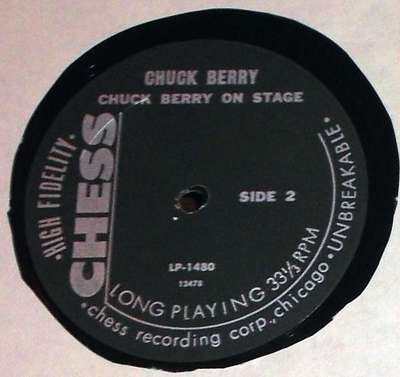
Thus we can sum up the history of CHESS LP-1480 as follows:
- The 'original' cover of 'Chuck Berry On Stage' did not have any printed text except for artist, label, and album name. At least some of these first versions had been available commercially.
- Before advertisements for this album were created and before advance copies were sent out to DJs, CHESS added a sticker referring to the most important songs. This became the second cover version.
- The third and final version must have been printed shortly after or even together with public release. This version had the song titles printed.
- The earliest copies had the multi-colored label with the chess knight logo, probably to demonstrate the new logo to DJs.
- Concurrently older design labels containing the vertical CHESS logo were used. These exist in blue as well as in different black variants.
- At least two different matrices existed to produce the bulk of the 1963 pressings.
To show just a few of these variants, Thierry arranged this photo:
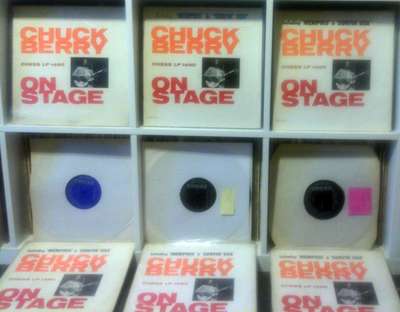
Many thanks to Thierry Chanu for providing all the additional information about the 'Chuck Berry On Stage' album. If we ever find the time, we'll continue this story with the international releases of this album which have different overdubs, longer fades, completely different covers (in multiple variation) and so on... [Done: http://www.crlf.de/ChuckBerry/blog/archives/235-Vinyl-variants-of-CHESS-LP-1480-Chuck-Berry-On-Stage.html]
Posted by Dietmar Rudolph
in Chuck Berry Rarities
at
13:49
| Comment (1)
| Add Comment
| Contact Webmaster
Friday, June 30. 2017
Big Beat magazine issue 26 contains more than 100 pages on Chuck Berry

Big Beat was a French fan magazine which started in the late 1960s and ended after 21 issues in the 1980s. Thirty-five years later the magazine was brought back to life with a 22nd issue. Since then it's purely digital with no paper releases. Issue 26 was recently published and is of huge interest to Chuck Berry collectors - even if you don't speak French.
Big Beat Magazine is a non-commercial project by Alain Mallaret created with a team of volunteers having pure passion for Blues, Country Music and Rock and Roll, just like the creators of this site and so many others around the world!
Issue #26 concentrates on Chuck Berry and includes both a very nice and interesting photo collection from Jean-Pierre Ravelli and a huge discography by Pierre Pennone. The contents of the discography follows more or less the contents of this site, which Pierre used and referred to. It is, however, limited to the official records released by Chess, Mercury and the likes as most of the 'official' discographies do. Pierre's discography fills almost 100 pages because he has managed to include hundreds of images showing labels, front and back covers, and sometimes even the booklets coming with the records. A minor thing to complain about is that Pierre did not always show the original records but used re-issues sometimes. All in all it's a great discography based on a huge amount of work. Well done, Pierre!
You can read Big Beat magazine at no charge from the Calaméo publication platform:
http://en.calameo.com/search#search-big%20beat%20magazine/books
Alain told me that there's also a PDF version of the magazine available. You cannot download it anywhere, but if you want one, Alain would send it to you. I won't publish Alain's email here, but if you contact me I'd be happy to forward your request. Alain also said that because this is a non-commercial project, you may freely give the PDF to other collectors interested.
It's great to have fellow collectors working so enthusiastically.
Many thanks to Alain and Pierre for their work and for telling me about it.
Big Beat Magazine is a non-commercial project by Alain Mallaret created with a team of volunteers having pure passion for Blues, Country Music and Rock and Roll, just like the creators of this site and so many others around the world!
Issue #26 concentrates on Chuck Berry and includes both a very nice and interesting photo collection from Jean-Pierre Ravelli and a huge discography by Pierre Pennone. The contents of the discography follows more or less the contents of this site, which Pierre used and referred to. It is, however, limited to the official records released by Chess, Mercury and the likes as most of the 'official' discographies do. Pierre's discography fills almost 100 pages because he has managed to include hundreds of images showing labels, front and back covers, and sometimes even the booklets coming with the records. A minor thing to complain about is that Pierre did not always show the original records but used re-issues sometimes. All in all it's a great discography based on a huge amount of work. Well done, Pierre!
You can read Big Beat magazine at no charge from the Calaméo publication platform:
http://en.calameo.com/search#search-big%20beat%20magazine/books
Alain told me that there's also a PDF version of the magazine available. You cannot download it anywhere, but if you want one, Alain would send it to you. I won't publish Alain's email here, but if you contact me I'd be happy to forward your request. Alain also said that because this is a non-commercial project, you may freely give the PDF to other collectors interested.
It's great to have fellow collectors working so enthusiastically.
Many thanks to Alain and Pierre for their work and for telling me about it.
Posted by Dietmar Rudolph
in Chuck Berry Rarities
at
15:21
| Comments (2)
| Add Comment
| Contact Webmaster
Friday, March 31. 2017
Picture Sleeve for CHESS 1883 Nadine - counterfeit or real?

$251.11 - That's what a collector this week paid for a picture sleeve of CHESS 1883, the U.S. original single Nadine. And just for the sleeve only!
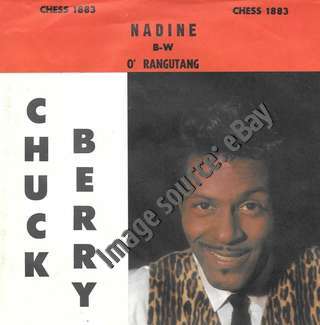
Why did this collector pay that much? Because nobody I know has ever seen this sleeve before.
There are similar looking picture sleeves for the CHESS singles following Nadine. But a PS for 1883 has been unknown.
We wonder if this sleeve truly is a genuine product. Or whether it's one of the many counterfeit picture sleeves popping up lately. Since the image on eBay looks reasonable and since the seller seems to be trusted, it may in fact be a long-lost item.
If you've been the buyer, let us know once you received it. What is your opinion?
Addition by Morten Reff:
Collectors should know that some of the US 45 picture sleeves had the titles only on one side whereas the other side had the same image and layout but no song titles. I also have one of these sleeves which has no song titles on both sides. Which would make it easy to imprint whatever you want.
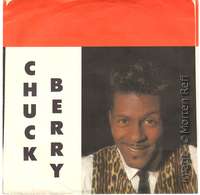

Why did this collector pay that much? Because nobody I know has ever seen this sleeve before.
There are similar looking picture sleeves for the CHESS singles following Nadine. But a PS for 1883 has been unknown.
We wonder if this sleeve truly is a genuine product. Or whether it's one of the many counterfeit picture sleeves popping up lately. Since the image on eBay looks reasonable and since the seller seems to be trusted, it may in fact be a long-lost item.
If you've been the buyer, let us know once you received it. What is your opinion?
Addition by Morten Reff:
Collectors should know that some of the US 45 picture sleeves had the titles only on one side whereas the other side had the same image and layout but no song titles. I also have one of these sleeves which has no song titles on both sides. Which would make it easy to imprint whatever you want.

Posted by Dietmar Rudolph
in Chuck Berry Rarities
at
14:49
| Comment (1)
| Add Comment
| Contact Webmaster
Monday, January 16. 2017
The Berry Pickin' Single - and what made it happen

Berry Pickin' is a Chuck Berry instrumental recorded in December 1955. Chess released it as a filler on the B side of Berry's first album After School Session and afterwards it was mainly forgotten. You won't find any discography which would list a 45rpm single containing Berry Pickin' ... except for our Chuck Berry Database!
This is because there indeed was a single which contains this instrumental even though only by error. Morten Reff has half a sentence about it in his "Chuck Berry International Directory, Volume 1", but you had to read the text very carefully. Morten owns a copy of the Berry Pickin' single, I have one, and maybe you do as well. Here's its story.
It's the story of the Chess single released in March 1957 with the catalog number 1653. One side of the record contains the song School Day, the other side contains the instrumental Deep Feeling.
To understand the story, we have to understand first how record production works. You'll probably know, but just in case here's a summary: Record production is a four-step process which starts in the recording studio and ends in the record pressing plant. Here the record is literally pressed by putting a blob of plastic (polyvinyl chloride PVC or short Vinyl, once also shellac) into a pressing machine which flattens it to a disk and presses the grooves into the two surfaces. During this also the labels are firmly attached to the record. To press the grooves into the disk, you need to have a negative for each side which has the grooves elevated. This negative is called a "stamper" and made from metal to allow the pressing of thousands of records. To create a stamper you have to have a positive model of the record to produce, typically one for each side of the final disk. This positive looks like an ordinary record having the grooves engraved. It can be played on a standard turntable e.g. for testing purposes. It is not made from vinyl, though. Instead this positive typically consists of a metal kernel coated with a soft material (wax, nitrocellulose lacquer, or in the 1930s cellulose acetate). These master disks are called lacquers or acetates. A turntable-like machine cuts the grooves containing the sound into a blank lacquer which then is used in an electroplating process to create the metal stamper. The record cutter gets the sound from a master tape (at least in the era we're talking about here) which contains the final recording along with all overdubs and mixes. If you need a lot of records (such as Chess in the 1950s) it made sense to add another, intermediate step between lacquer and stamper which allows you to create many stampers for pressing in multiple presses and pressing plants. To do so, the lacquer is first transferred into a negative "father" record using electroplating. Then this "father" record is used to create multiple positive "mother" records, also known as "matrix" records (plural "matrices"). These matrices were checked and then sent out to the pressing-plants to create the stampers.
Let's go back to Chess 1653. After recording and whatever overdubs and fades were needed, the production process began with a magnetic tape containing the master recording. For identification purposes, each master tape was given a unique number. In this case, the final recording of Deep Feeling got the number 8378 and the final recording of School Day got 8379. Our database lists those where known. Using a record cutter both master tapes were transferred to at least two different lacquers. We know that there has been more than one lacquer as Chess 1653 was pressed both at 7-inch size to be played at 45rpm and at 10-inch size to be played at 78rpm. You needed different matrices for each obviously. The lacquer for the 7-inch 45rpm singles was electroplated into multiple mother disks or matrices. Again we know that there must have been more than one matrix, as original silver-top issues of Chess 1653 have been made from slightly different matrices.
You can tell by looking at the writing in the inner "dead wax" area of the single. On some copies you find the numbers 45-8378 x and 45-8379 x engraved. This additional engraving was either hand-written on the lacquer after the grooves have been cut or - more probably - added to the mother disk after checking. The mother disk going to the Plastic Products Co. in Memphis had a different engraving which reads chess 45•8378 PP and chess 45•8379 PP so the Memphis people could easily see to which label the disk belonged.
According to discogs other copies read 45-8378 Δ 15319 and 45-8379 x Δ 15318 which is the code for the Monarch Records pressing plant in Los Angeles. There are also silver-top copies where the etching reads CH-8378 and CH-8379, though these may be 1970s re-issues.
Note that the variety of labels known from Chess 1653 has also to do with the multitude of records needed. Some pressing plants had printers on site who created labels, some got them for external sources. But while the layout was probably given by Chess, the letter size and placement was done at the individual print shops. We know of silver-top labels having "School Day" within quotation marks and others that don't. Also some labels had a sub-title of (Ring! Ring! Goes The Bell) below the song name, others didn't.
After its original success Chess 1653 has been re-produced often. There are re-issues with every type of label the Chess company used during the late 1950s, 1960s and early 1970s. Up to the mid-60s these re-issues seem to have been created from the original matrices having 45-8378 and 45-8379 engraved.
Sometime around 1965, Chess once more needed re-issues of Berry's old hits. However, they decided not to re-use the old lacquers but to create new ones from the master tapes. One reason was that the fad of the time required stereo records. So Chess tried to refresh the old mono records. They altered the sound electronically to make it sound like stereo. Judging from today, this enhancement was probably the worst they could do with the old master tapes, but they did.
This new re-issue had a light-blue label. The catalog number reads "1653" as on the original 1957 release and the correct instrumental Deep Feeling can be heard. You can tell that new lacquers have been made by looking at the engraving of this variant. Instead of 8379 for School Day the etching erroneously reads 8370 here.
For whatever reason, only a few years later Chess once again decided to create new lacquers, probably around 1967 and with even inferior sound. Again we can tell that new lacquers were made because this next re-issue has another new etching in the "dead wax" (8379 TM5416 CH1653 SG where TM stands for Chess'es own Ter-Mar Pressing Plant and SG might stand for mastering engineer Geoff Sykes).
The label to this re-issue is almost identical to the light-blue one shown above. You can recognize these new ones not only by the TM text in the wax, but also by its label print. The records of this second set have the same light-blue 1960s Chess label but - most importantly - list a catalog number of "CH 1653".
This is the interesting variant! On the B side this second light-blue re-issue not only has a different dead wax, it also has different grooves for the song!
By error someone at Ter-Mar Recording Studios took the wrong master tape to cut the new lacquer. On this B side is a Chuck Berry instrumental, but it's not Deep Feeling! Instead they took the tape of master U7953 which is Berry Pickin'. The faulty lacquers went into production unnoticed and records were pressed.
This must have been a time at the Chess company when somebody got totally confused over which master tapes to use for re-issues. Besides the incorrect pressing of Chess CH-1653 there exist at least two other light-blue re-issues with incorrect contents. Bo Diddley expert George White told me that he owns a light-blue re-issue of Chess 1744 (Howlin' Wolf - The Natchez Burning b/w You Gonna Wreck My Life) where the A side plays I'm Going Away instead. And he knows of a light-blue re-issue of Checker 819 (Bo Diddley - Diddley Daddy b/w She's Fine, She's Mine) where the A side incorrectly plays The Great Grandfather. So whoever was in charge at Chess when the light-blue re-issues were mastered, he either couldn't read or hear.
Many thanks to Morten Reff and Thierry Chanu for their tremendous help with this article!
This is because there indeed was a single which contains this instrumental even though only by error. Morten Reff has half a sentence about it in his "Chuck Berry International Directory, Volume 1", but you had to read the text very carefully. Morten owns a copy of the Berry Pickin' single, I have one, and maybe you do as well. Here's its story.
It's the story of the Chess single released in March 1957 with the catalog number 1653. One side of the record contains the song School Day, the other side contains the instrumental Deep Feeling.
To understand the story, we have to understand first how record production works. You'll probably know, but just in case here's a summary: Record production is a four-step process which starts in the recording studio and ends in the record pressing plant. Here the record is literally pressed by putting a blob of plastic (polyvinyl chloride PVC or short Vinyl, once also shellac) into a pressing machine which flattens it to a disk and presses the grooves into the two surfaces. During this also the labels are firmly attached to the record. To press the grooves into the disk, you need to have a negative for each side which has the grooves elevated. This negative is called a "stamper" and made from metal to allow the pressing of thousands of records. To create a stamper you have to have a positive model of the record to produce, typically one for each side of the final disk. This positive looks like an ordinary record having the grooves engraved. It can be played on a standard turntable e.g. for testing purposes. It is not made from vinyl, though. Instead this positive typically consists of a metal kernel coated with a soft material (wax, nitrocellulose lacquer, or in the 1930s cellulose acetate). These master disks are called lacquers or acetates. A turntable-like machine cuts the grooves containing the sound into a blank lacquer which then is used in an electroplating process to create the metal stamper. The record cutter gets the sound from a master tape (at least in the era we're talking about here) which contains the final recording along with all overdubs and mixes. If you need a lot of records (such as Chess in the 1950s) it made sense to add another, intermediate step between lacquer and stamper which allows you to create many stampers for pressing in multiple presses and pressing plants. To do so, the lacquer is first transferred into a negative "father" record using electroplating. Then this "father" record is used to create multiple positive "mother" records, also known as "matrix" records (plural "matrices"). These matrices were checked and then sent out to the pressing-plants to create the stampers.
Let's go back to Chess 1653. After recording and whatever overdubs and fades were needed, the production process began with a magnetic tape containing the master recording. For identification purposes, each master tape was given a unique number. In this case, the final recording of Deep Feeling got the number 8378 and the final recording of School Day got 8379. Our database lists those where known. Using a record cutter both master tapes were transferred to at least two different lacquers. We know that there has been more than one lacquer as Chess 1653 was pressed both at 7-inch size to be played at 45rpm and at 10-inch size to be played at 78rpm. You needed different matrices for each obviously. The lacquer for the 7-inch 45rpm singles was electroplated into multiple mother disks or matrices. Again we know that there must have been more than one matrix, as original silver-top issues of Chess 1653 have been made from slightly different matrices.
You can tell by looking at the writing in the inner "dead wax" area of the single. On some copies you find the numbers 45-8378 x and 45-8379 x engraved. This additional engraving was either hand-written on the lacquer after the grooves have been cut or - more probably - added to the mother disk after checking. The mother disk going to the Plastic Products Co. in Memphis had a different engraving which reads chess 45•8378 PP and chess 45•8379 PP so the Memphis people could easily see to which label the disk belonged.
According to discogs other copies read 45-8378 Δ 15319 and 45-8379 x Δ 15318 which is the code for the Monarch Records pressing plant in Los Angeles. There are also silver-top copies where the etching reads CH-8378 and CH-8379, though these may be 1970s re-issues.
Note that the variety of labels known from Chess 1653 has also to do with the multitude of records needed. Some pressing plants had printers on site who created labels, some got them for external sources. But while the layout was probably given by Chess, the letter size and placement was done at the individual print shops. We know of silver-top labels having "School Day" within quotation marks and others that don't. Also some labels had a sub-title of (Ring! Ring! Goes The Bell) below the song name, others didn't.
After its original success Chess 1653 has been re-produced often. There are re-issues with every type of label the Chess company used during the late 1950s, 1960s and early 1970s. Up to the mid-60s these re-issues seem to have been created from the original matrices having 45-8378 and 45-8379 engraved.
Sometime around 1965, Chess once more needed re-issues of Berry's old hits. However, they decided not to re-use the old lacquers but to create new ones from the master tapes. One reason was that the fad of the time required stereo records. So Chess tried to refresh the old mono records. They altered the sound electronically to make it sound like stereo. Judging from today, this enhancement was probably the worst they could do with the old master tapes, but they did.
This new re-issue had a light-blue label. The catalog number reads "1653" as on the original 1957 release and the correct instrumental Deep Feeling can be heard. You can tell that new lacquers have been made by looking at the engraving of this variant. Instead of 8379 for School Day the etching erroneously reads 8370 here.
For whatever reason, only a few years later Chess once again decided to create new lacquers, probably around 1967 and with even inferior sound. Again we can tell that new lacquers were made because this next re-issue has another new etching in the "dead wax" (8379 TM5416 CH1653 SG where TM stands for Chess'es own Ter-Mar Pressing Plant and SG might stand for mastering engineer Geoff Sykes).
The label to this re-issue is almost identical to the light-blue one shown above. You can recognize these new ones not only by the TM text in the wax, but also by its label print. The records of this second set have the same light-blue 1960s Chess label but - most importantly - list a catalog number of "CH 1653".
This is the interesting variant! On the B side this second light-blue re-issue not only has a different dead wax, it also has different grooves for the song!
By error someone at Ter-Mar Recording Studios took the wrong master tape to cut the new lacquer. On this B side is a Chuck Berry instrumental, but it's not Deep Feeling! Instead they took the tape of master U7953 which is Berry Pickin'. The faulty lacquers went into production unnoticed and records were pressed.
This must have been a time at the Chess company when somebody got totally confused over which master tapes to use for re-issues. Besides the incorrect pressing of Chess CH-1653 there exist at least two other light-blue re-issues with incorrect contents. Bo Diddley expert George White told me that he owns a light-blue re-issue of Chess 1744 (Howlin' Wolf - The Natchez Burning b/w You Gonna Wreck My Life) where the A side plays I'm Going Away instead. And he knows of a light-blue re-issue of Checker 819 (Bo Diddley - Diddley Daddy b/w She's Fine, She's Mine) where the A side incorrectly plays The Great Grandfather. So whoever was in charge at Chess when the light-blue re-issues were mastered, he either couldn't read or hear.
Many thanks to Morten Reff and Thierry Chanu for their tremendous help with this article!
Posted by Dietmar Rudolph
in Chuck Berry Rarities
at
15:02
| Comments (0)
| Add Comment
| Contact Webmaster
Saturday, March 5. 2016
Was Mercury 72963 a regular release? Update

In November 2013 we finally gave up. For decades Morten Reff and I had tried to find a regular copy of Berry's fifth single for Mercury It's Too Dark In There / Good Lookin' Woman (Mercury 72963). While you can buy white-label promotional (WLP) copies of this single easily, we never even saw a regular copy with the commercial Mercury label.
The regular red Mercury label. This one:
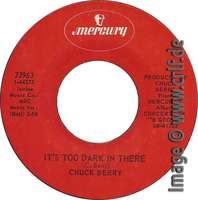
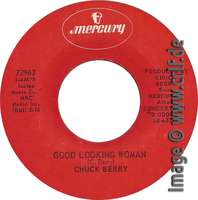
Yes, it exists! Who else but reader (or shall I say contributor) Thierry Chanu found this absolute rarity!
This is the only copy of Mercury 72963 having a regular company label we know of. It came to him in the paper sleeve of the promotional copies, Thierry remembers.
So this still does not answer the question whether It's Too Dark In There / Good Lookin' Woman was ever sold in stores. It still may be that even this copy was sent out by Mercury as a promotional item. Until I see other red label copies offered in used-record shops or on the Net, I continue saying that this single was announced only but never sold. Convince me ...
The regular red Mercury label. This one:


Yes, it exists! Who else but reader (or shall I say contributor) Thierry Chanu found this absolute rarity!
This is the only copy of Mercury 72963 having a regular company label we know of. It came to him in the paper sleeve of the promotional copies, Thierry remembers.
So this still does not answer the question whether It's Too Dark In There / Good Lookin' Woman was ever sold in stores. It still may be that even this copy was sent out by Mercury as a promotional item. Until I see other red label copies offered in used-record shops or on the Net, I continue saying that this single was announced only but never sold. Convince me ...
Posted by Dietmar Rudolph
in Chuck Berry Rarities
at
17:46
| Comments (0)
| Add Comment
| Contact Webmaster
Tuesday, October 13. 2015
The Chuck Berry Vinyl Bootlegs, Vol. 4: Telecasts

This series of articles is going to describe the Chuck Berry vinyl bootlegs released in the 1970's and 1980's. For any record collector these items are important to know of, even though you don't necessarily need to have them. Omitted from all the usual discographies, information about these records is next to void. Given the secret nature of the bootlegger business there are no exact dates, numbers, or origins. I have tried to collect this information from various sources and mostly from my own collection of records. If you can add anything of worth to the information given here, I'd be glad to know!
This is the fourth part of this series and it covers a record which isn't really a Chuck Berry bootleg.
John Lennon (featuring Yoko Ono & Chuck Berry) - Telecasts - Trade Mark of Quality 71046 (and multiple other labels/numbers)
Of all bootleg records containing unreleased Chuck Berry recordings, this one is probably the best-sold and the one of which the most variants exist. This is because it's not a Chuck Berry bootleg at all. Telecasts is a John Lennon bootleg, but it contains two recordings from the Mike Douglas TV show of February 3rd, 1972. In this show, co-hosted by Lennon, the ex-Beatle invited Berry as a guest performer. Two songs were recorded, Lennon and Berry singing duets backed by Elephant's Memory and Lennon's wife Yoko Ono: Memphis, Tennessee and Johnny B. Goode. Further segments from the show such as an interview with Berry and a cooking scene did not make it to this bootleg.
During research for this article, I learned a lot about bootleg creation in the 1970's. I strongly suggest you take some time to read the excellent blog The Amazing Kornyfone Label. If you follow closely the stories of Ken Douglas, one of the most famous early bootleggers, you'll learn that research is almost impossible. They never thought about getting their acts organized in any business sense. Which makes it more or less arbitrary how the records looked like. The color of the vinyl, for instance, was more or less random. The record pressing company just used what was lying around. Even in the same production run multiple colors were used. The same with labels or covers: any color, any print. Early bootlegs had their name placed on blank covers using a rubber stamp, but if there wasn't enough time, only some were stamped, others not. Due to this, bootlegs from Ken's Trade Mark Of Quality label (and others) exist in dozens of variants and no-one can tell which ones were produced when or in which quantity. Here is what I think might be the most probable history of this Berry bootleg.
It seems that the very first version of this bootleg was produced by the legendary Los Angeles-based bootleg label "Trade Mark Of Quality". The exact date is not known, but is must have been by the end of 1972. At that time the operation was run by Ken together with Dub Taylor. They used a so-called "Farm Pig" logo on stickers, inserts, and (sometimes) labels. The initial release had a catalogue number of TMQ 71046 which was printed on an insert (xeroxed on color paper). It came in a white or colored cover with or without a rubber-stamp reading "John Lennon (featuring Yoko Ono & Chuck Berry) Telecasts". Labels seem to contain the Farm Pig logo, but also other labels exist. Note that TMQ 71046 has been copied in later years with no or little difference. This means there are bootleg copies of this bootleg.
This might be the original version of TMQ 71046:
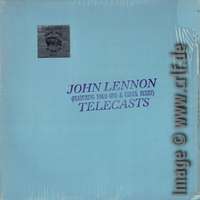
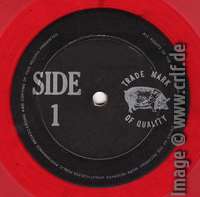
The matrix number etched in the dead wax of TMQ 71046 reads JL-517 A/B. It's not quite clear what this number stands for. JL of course is short for John Lennon. 517 seems to be some internal numbering at TMQ. There is for instance a Bob Dylan bootleg numbered BD-516.
The letter-sized photo-copied insert on colored paper contains poor quality photos from the shows including Berry and Lennon performing together.
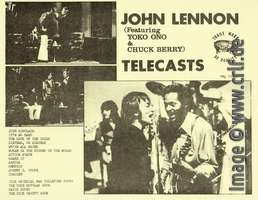
The tracks on this record are as follows (spelling as on the sheet):
Side 1
- JOHN SINCLAIR
- IT'S SO HARD
- THE LUCK OF THE IRISH
- SISTERS, OH SISTERS
- WE'RE ALL WATER
- WOMAN IS THE NIGGER OF THE WORLD
Side 2
- ATTICA STATE
- SHAKE IT
- SAKURA
- MEMPHIS
- JOHNNY B. GOODE
- IMAGINE
In addition the sheet tells:
THIS MATERIAL WAS COLLECTED FROM:
THE MIKE DOUGLAS SHOW
DAVID FROST
THE DICK CAVETT SHOW
Shortly after the initial release of TMQ 71046 the owners of the label (if you can call them 'owners') split and formed separated bootleg labels. Ken Douglas continued using the Trade Mark Of Quality name. These second version records show a different TMQ logo, though. While the original label had a so-called "Farm Pig" logo, the second version uses the so-called "Smoking Pig" label. Douglas re-used the original tapes to produce his own TMOQ records.
The second variant of Telecasts has the TMQ number 1834 which is etched in the dead wax. Thus a different matrix was used. It came in completely white covers. Both the insert and the labels show the Smoking Pig logo.
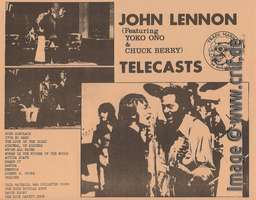
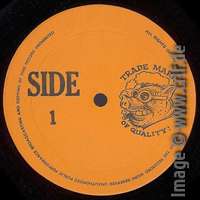
Concurrently with the TMQ release(s) or not much later (appr. 1973) another variant of this bootleg has been produced from yet another matrix. This time the etching reads WEC-3711. The "company" is known as Contraband Music but this name doesn't appear on cover or label. The cover is blank with a full-size insert in brown on white. The labels are white with a rubber-stamped A and B.
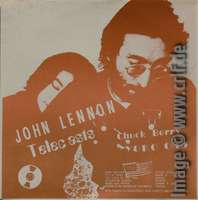
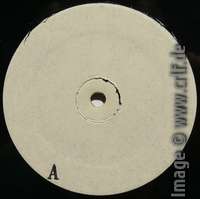
The original TMQ matrix with the etching JL-517 (or copies thereof) has been used very often. This record exists in a multitude of covers and comes with a multitude of labels. Here's one example of a modified insert. This version had plain green labels. This may be a later or even an earlier version. Have a look at Bob's Boots discussion of TMOQ cover and label variants of a Bob Dylan bootleg.
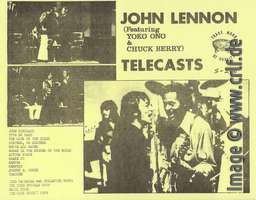
For more variants of JL-517 see images here (Great Live Concerts 6012-4299) and here (Box Top Records). The best known version of JL-517 is the one with the full-color photograph of the bearded Lennon sitting at a piano in front of an audience. This version also has a full-color back cover. It is this cover on which the bootleggers first forgot to list the second track from side 2 "Shake it". The song is only missing from the track listing. On the record it still is. This error has been repeated ever since.
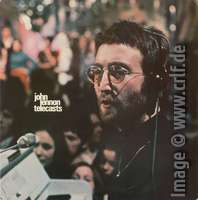
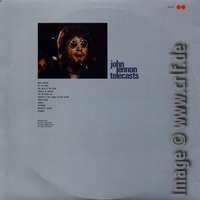
The labels of the photograph version are blank white. Both cover and record have been reproduced often. One version has a dog label (image at discogs here). In addition JL-517 has been used to produce one of the records in two-, three- or even nine-record sets such as John Lennon - Flower and John Lennon - The Plastic Ono Box.
The full-color photo from JL-517 has also been used to produce a picture disk. A picture disk is made out of transparent vinyl with a full-size print in between the two layers for the two sides. One should note that for the picture disk an even different master has been used (probably due to production reasons). The picture disk is etched 4-A and 4AB in the dead wax.
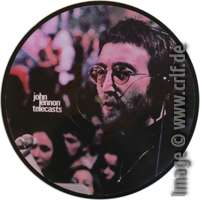
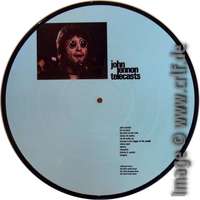
While Telecasts was the first bootleg containing the two Lennon/Berry duets, the same recordings have been used on other, later bootlegs as well. These contain different remaining Lennon recordings, typically other duets with Jimi Hendrix or Elton John. Examples of such bootlegs are the two LP set Working Class Hero (Chet Mar CMR-75, image), the Australian two LP set Stand By Me (Toasted Records TRW-1942, see below), and the single LPs The Joshua Tree Tapes (The Kornyphone Records for the Working Man TKRWM 1803, Johnny B. Goode only, image) and John Lennon with (LSD Record JCJ-37037, again see below).
The Toasted Records cover tells that there's a third duet from the Mike Douglas show (Roll Over Beethoven). This is incorrect, though. There's no Chuck Berry on that recording. Also note the spelling of Chuck on the LSD Record cover.
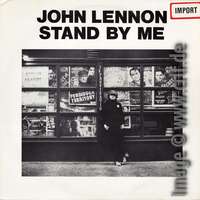
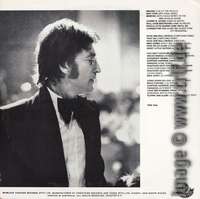
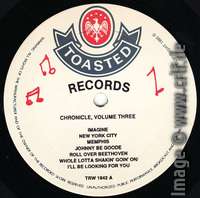
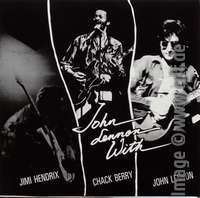
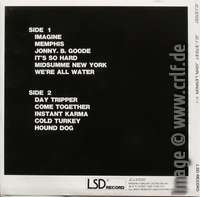
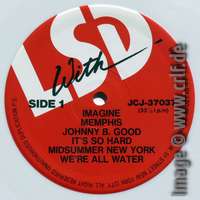
A (probably) legal release of the two songs plus the interview with questions to Berry, Lennon, and Ono was released in 2011 as a three CD set called Chuck Berry in the 1950s (Chrome Dreams CD3CD5073, 2011). You can also buy DVDs containing the complete show.
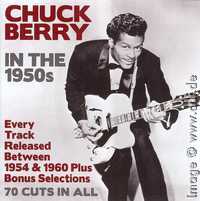
Thanks to Morten Reff for photos of the original TMQ record and the Toasted bootleg. All other images show records from my own collection.
To read the other parts of this series on Chuck Berry vinyl bootlegs, click here:
Posted by Dietmar Rudolph
in Chuck Berry Rarities
at
15:10
| Comments (0)
| Add Comment
| Contact Webmaster
(Page 1 of 3, totaling 44 entries)
» next page
Main Page
This weblog is an addition to my Chuck Berry fansite called "A Collector's Guide to the Music of Chuck Berry" which describes all books and records of interest to everyone enjoying Chuck Berry's music.
Categories
What You Missed
Some earlier but important entries:
- Unanswered questions about the recording of Memphis, Tennessee
- Sweet Little Eight Variants of Sweet Little Sixteen
- The Johnny B. Goode Session
- Chuck Berry in Stereo
- Chuck Berry's Recording Session for Volkswagen
- Chuck Berry's Recording Session for Dr Pepper
- Tim McFarlin Introduces the Berry-Johnson Test into American Copyright Law
- Chuck Berry's Early Recording Locations
- Run! Rudolph, the Red-Nosed Reindeer â and the copyright mystery
- Chuck Berry live in New York 1956
- The very first Chuck Berry LP album
- The Chuck Berry On Stage (Chess LP-1480) confusion continues
- The Chuck Berry Vinyl Bootlegs, Vol. 1: Rare Berries
- Rocksmuk album - bootleg or not?
- 6034 cover versions of Chuck Berry songs
- Chuck Berry's Greatest Hits (Chess LP-1485) variants
Recent Entries
- CHUCK100 Tribute EP Series
- Thursday, January 16 2025
- CBID - Corrections, Additions, New Covers
- Friday, January 10 2025
- Rhythm and Rhyme - Chuck Berryâs poetic heartbeat
- Sunday, December 22 2024
- CBID - 6034 and counting ...
- Friday, November 1 2024
- CBID - 6034 cover versions of Chuck Berry songs
- Friday, July 5 2024
- CBID - The Never Ending Story - pt. 9
- Monday, June 10 2024
- CBID - The Never Ending Story - pt. 8
- Tuesday, June 4 2024
- CBID - The Never Ending Story - pt. 7
- Monday, April 22 2024
- Peter OâNeilâs So-Called Disorder
- Friday, April 12 2024
- The Chuck Berry Sound according to Atomicat
- Wednesday, April 10 2024
- CBID - The Never Ending Story - pt. 6
- Wednesday, April 3 2024
- CBID - The Never Ending Story - pt. 5
- Saturday, March 16 2024
- CBID - The Never Ending Story - pt. 4
- Monday, February 19 2024
- CBID - The Never Ending Story - pt. 3
- Monday, February 5 2024
- CBID - The Never Ending Story - pt. 2
- Monday, January 22 2024
- The Chuck Berry Vinyl Bootlegs, Vol. 3: America's Hottest Wax
- Tuesday, January 16 2024
- Chuck Berry in Fake Stereo
- Friday, January 12 2024
- CBID - The Never Ending Story
- Thursday, January 11 2024
- CBID - 5639 cover versions of Chuck Berry songs
- Tuesday, October 31 2023
- CBID - Covers, Chart Listings, and Not-Covers
- Monday, August 28 2023
- CBID - And they play Chuck Berry music - final part 10
- Monday, March 27 2023
- Little Queenie overdubs
- Monday, March 13 2023
- CBID - And they play Chuck Berry music - part 9
- Saturday, March 4 2023
- Lonely School Days - the variants explained
- Tuesday, January 31 2023
- An Interview with Johnnie Johnson - 1987
- Sunday, January 29 2023
Search
Copyright and Disclaimer
The complete contents of this weblog is
© Dietmar Rudolph
No part of this document may be used or published without written consent by the author.
Impressum/Haftungsausschluss/Datenschutz/Disclaimer
To contact the authors, email to cbguide@crlf.de.
© Dietmar Rudolph
No part of this document may be used or published without written consent by the author.
Impressum/Haftungsausschluss/Datenschutz/Disclaimer
To contact the authors, email to cbguide@crlf.de.
